Important Structural Differences Between Dinosaurs and Birds
According to the hypothesis currently favored by most evolutionists, birds descended from small theropod dinosaurs (theropod being the name generally given to carnivorous dinosaurs such as Tyrannosaurus rex and velociraptors). Storrs L. Olson, president of the Smithsonian Institute's Ornithology Department, refers to this claim, which evolutionists are unable to back up with any scientific evidence, as "one of the grander scientific hoaxes of our age." 34
Any comparison of living birds and reptiles shows that these classes are very different from each other and that no evolution could have transformed the one into the other. In evolutionist publications, however, all these differences are completely ignored, or dismissed as questions that can be easily resolved.
Below is an example of accounts, aired on a well-known TV documentary station, the Discovery Channel, yet far divorced from any scientific validity:
The evolution of birds is still one of the most hotly debated scientific issues. It appears that the ancestors of birds were reptiles 200 million years ago. When they went into the trees, they developed a scaly layer that would become a primitive wing. These wings helped them to come down from the trees more easily. 50 million years later, Archaeopteryx came on the scene. It still had teeth and hard bones like a reptile, but unlike other creatures, it had feathers. Like scales, feathers are made of keratin, but they are lighter and more flexible. Archaeopteryx could fly.
Within the next 25 million years, it developed a greater flying ability, and every surplus gram of weight was lost. It even lost its teeth to make it lighter. Its bones had a texture like a beehive which gave them strength. About 50 million years ago, the number of mammals increased, and birds appeared that could hunt them—birds of prey were born. 35
 |
| There is no creature on Earth which is not dependent upon Allah for its provision. He knows where it lives and where its dies. They are all in a Clear Book.(Surah Hud, 6) |
By resorting to such a fairy tale-like style, the Discovery Channel seeks to imply that a transition from reptiles to birds is perfectly reasonable. It needs to do such a thing because evolutionist claims are devoid of any scientific evidence. There are actually insuperable differences between the two living species. As you already saw, claims of avian evolution, though depicted as scientific fact, are totally lacking in evidence. No intermediate form to back them up has ever been found.
First of all, the structural differences between dinosaurs and birds is too great to be bridged by any evolutionist account. Birds' unique anatomy allows them to fly. The fossil record is unable to offer any evidence that any evolution between these two very different groups ever took place. Therefore, the theory that birds are descended from dinosaurs is rejected even by some biologists and paleontologists who subscribe to the theory of evolution.
For instance, the world-renowned ornithologist Alan Feduccia of North Carolina University and Larry Martin of The University of Kansas take the view that birds cannot have evolved from any known dinosaur group. Feduccia despite being a believer in evolution, points to the evidence fact that there are enormous differences between dinosaurs and birds and shows that the latter cannot have evolved from the former.
When the anatomies of theropod dinosaurs and birds are examined, it can be seen that there is no evolutionary relationship between them. Alan Feduccia sets out the impossibility of theropods evolving into flying creatures:
It's biophysically impossible to evolve flight from such large bipeds with foreshortened forelimbs and heavy, balancing tails. 36
There are deep physiological gulfs between birds and dinosaurs. First of all, wings—the attribute that makes a bird a bird—represent a major dilemma for evolutionists. How did the wing's flawless structure came into existence through consecutive random mutations, as evolutionists would have us believe? The question goes unanswered. Also, evolutionists cannot explain how a reptile's forearms could have turned into a flawless wing as a result of mutations—defects arising in its genes.
Many Species Exist in the Fossil Record with the Perfect Forms they have Today |
 |
| Conjectural Drawing (2, 3, 4) |
| (1) A dinosaur, many of which we see in the fossil record. |
In addition, wings alone are not sufficient to turn a land-dwelling animal into a bird. Land-dwellers lack many other structures and mechanisms that birds use to fly. As you've seen, birds' bones are much lighter, and their lungs and far more specialized coronary-circulation system have very different structures and functions. Their muscular and skeletal structures are different. It is impossible for these mechanisms to have accumulated gradually, as evolutionists would have us believe.
In any case, fossils reveal that no such transition ever happened. This situation, which represents such a predicament for evolutionists, was described in a New Scientist article entitled, "Birds Do It . . . Did Dinosaurs?"
Neither their hypothetical ancestor nor transitional forms linking it to known fossil birds have been found. 37
For a reptile to acquire so-called avian features, according to evolutionist claims, it would have to undergo countless mutations. Just the so-called development of a reptile's front legs into wings, for example, would demand an endless procession of gradual changes. Every mutation in the genetic information regarding the forelegs must cause certain small alterations, and each one must make them a little more wing-like, not less. For example, fur must gradually appear on the limbs, then feathers must gradually appear in future generations —first the stem and then the other components. The digits must shrink with every passing generation, and the limb must increasingly come to resemble a wing. These slow, gradual changes—in the animal's lungs, its scales turning into feathers, changes in its bone structures and other characteristics— should appear in the fossil record.
But every one of these intermediate stages that evolutionists claim took place actually represents a disadvantage. Since these structures are not fully formed or fully functional, these transitional species will be unable to survive. Right away this conflicts with the "survival of the fittest" claims of evolutionists; their theory thus refutes itself.
As you can clearly see, any evolution from reptiles to birds should have left millions of intermediate forms to demonstrate the fact. Yet to date, not a single half-reptile, half-bird fossil has ever been found. The existing fossils provide no evidence for evolution, but belong to extinct birds or extinct reptiles—proof of creation. The dino-bird stories we so often encounter in the media are mere fairy tales, as you shall soon see. None of these provide the so-called missing link in the evolution of birds.
Gordon Rattray Taylor, himself an evolutionist, describes the theory's inability to account for the birds' origin:
...the number of modifications in reptilian structure which the birds have managed to effect in order to adapt themselves for flight is so large as to constitute a real problem and deserves our further attention. To begin with, many modifications serve to reduce its weight. The bones are hollow, the skull very thin. It has abandoned the heavy tooth-studded jaw for the light but rigid beak. The body is condensed into a compact shape, the reptilian tail being abandoned, as also the reptilian snout. The centre of gravity has been lowered by placing the chief muscles beneath the main structure. Where organs are paired, like the kidney, and the ovary, one has been sacrificed. The pelvis has been strengthened to absorb (allow me the teleology) the shock of landing. The legs and feet have been reduced to a minimum; the muscles operating them have vanished, to be replaced by muscles within the body. The brain has been modified: a larger cerebellum to handle problems of balance and co-ordination, a larger visual cortex now that vision has become more important than smell. Less obvious but even more remarkable is the change in bodily metabolism.
To produce the energy for flight, the bird must consume a lot of fuel and maintain a high [body] temperature. Not only do birds eat a lot, as anyone who grows fruit or has seen the bullfinches systematically remove every bud from a treasured shrub knows, but they have a crop in which they can store fuel. So that it can handle more blood, the partitions in the heart have been completed. The lungs too have not only been enlarged but are supplemented by air-spaces within the body. In land creatures like ourselves, much of the air in the lungs remains static; we exchange only a very small proportion of it in a normal breath. The bird, by passing the inspired air right through the lung into the air-sacs, contrives to exchange the lot with each breath. This system also serves to dissipate the heat generated by the muscles during flight.
It strains the imagination to visualise so many beautifully apt changes occurring by chance, even when one considers that 150 million years elapsed between the emergence of life from the sea and the appearance of the first birds. For my part, I can imagine that each change might have occurred by chance during that time. What I find hard to swallow is the accumulation of different changes integrated into a single functional pattern. 38
Gordon Taylor is stating why avian evolution is an impossibility; yet a great many evolutionists still persist in believing in it. The reason for this lies in their philosophical prejudices. In order to deny Allah's creation, evolutionists display a blind devotion to their claims. Despite the lack of any evidence to support their claims—and even though those claims have been demolished countless times—still they refuse to accept the fact of creation.
For anyone pondering over the subject without prejudice, the conclusion to which science leads is creation. At the same time, this fact is revealed in the Qur'an. The Qur'an states that "Among His Signs is the creation of the heavens and Earth and all the creatures He has spread about in them …" (Surat ash-Shura, 29) and "And in your creation and all the creatures, He has spread about there are Signs for people with certainty." (Surat al-Jathiyya, 4).
In other verses Allah refers to the variety of life:
Have they not seen how We created for them, by Our own handiwork, livestock which are under their control? We have made them tame for them and some they ride and some they eat. And they have other uses for them, and milk to drink. So will they not be thankful? They have taken gods besides Allah so that perhaps they may be helped. They cannot help them, even though they are an army mobilized in their support. (Surah Ya Sin, 71-75)
Avian Bone Structure Created Especially For Flight
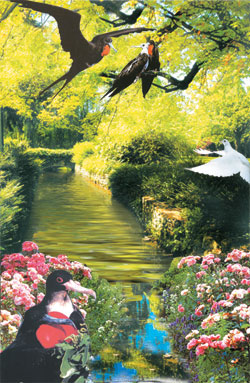 |
| A frigate bird's bones weigh a total of 118 grams (0.2601 of a pound)—. less than the total weight of its feathers. The fact that its bones are so light plays a major role in terms of flight. That birds have bones that are thin, hollow but strong–in exactly the right form to meet their needs– is yet another example that invalidates evolutionist scenarios based on chance. As revealed in the Qur'an by our Almighty Lord "It is He Who created everything and determined it most exactly." (Surat al-Furqan, 2) |
Of the many structural differences between birds and reptiles, from the point of view of flight, one of the most important is bone structure. Reptile bones are heavy, thick and solid. But birds' bones must be both strong and light—very thin and hollow, but still strong despite that. Light, fine bones make it easier for birds to fly, reducing air resistance to a minimum and reducing the amount of energy needed to take off and remain aloft.
Although hollow, bird bones are very strong in terms of the power possessed by birds. For example, the beak of the hawfinch, a bird only 18 centimeters (7-inches) long, can apply 68.5 kilograms (151 pounds) of pressure to break an olive pit. In contrast to those of terrestrial animals, the avian skeleton fuses together the shoulder, hip and breast bones. This lends the bird further solidity. Additionally, this structure reduces the amount of sinews and tendons to hold the skeleton together, making the bird even lighter.
As stated earlier, the avian skeleton is lighter than that of all other vertebrates. A pigeon's skeleton, for instance, represents only 4.4% of the bird's total body weight. A frigate bird's bones weigh 118 grams (0.260 pounds less than the total weight of its feathers!)
Henry Gee, editor of the scientific magazine Nature, reports this characteristic of birds:
Their breastbones are large, serving as anchors for powerful muscles; their collarbones are united to form a flexible spring brace ...Their backbones are tight, interlocked, and stiff, the interlocking ribs contributing to a rigid cage, and yet many of the bones are hollow: lightweight yet strong, like tubular steel. Their pelvis and sacrum are welded together into a solid structure. Overall, the body of birds combines lightness with strength. 39
This anatomy, unique to birds, is completely different from that of reptiles. Nonetheless, the evolutionary scenario of dinosaur to bird is still blindly defended, though based on no concrete evidence at all. (We shall look at detailed instances in due course.)
Certain concepts, being misunderstood, are imagined to represent evidence for the theory. Based on the differences in dinosaur pelvic bones, for example, some evolutionist publications suggest that birds evolved from dinosaurs. These differences lie between dinosaurs belonging to the Saurischian (lizard-hipped) and Ornithischian (bird-hipped) groups. From time to time, the existence of dinosaurs with bird-like hip bones is perceived as evidence for the claim of dino-bird evolution. Yet the hip bone similarity provides no support for dinosaurs being the ancestors of birds. Dinosaurs belonging to the Ornithischian group bear no similarity to birds at all with regard to their other features.
Ankylosaurus for example, had short legs, a giant torso and armor-like scaly skin, and is even compared to a battle tank. Yet it is a member of the Ornithischian family, with bird-like hip bones. On the other hand, some anatomical features of Strithiomimus can be compared to those of birds. It was long legged and had short front legs, but is actually a member of the Saurischian family of dinosaurs, with reptile-like hip bones. 40
In short, hip bone structure constitutes no evidence of any relationship between dinosaurs and birds, as evolutionists claim. The name "bird-hipped dinosaur" stems from mere resemblance, but the other enormous differences between the two groups make it impossible to view this similarity from an evolutionary perspective.
Many other problems are attendant upon the theory asserting that birds evolved from dinosaurs. Compared with Archaeopteryx, regarded as the oldest known bird, the forearms of theropod dinosaurs are very short in relation to their bodies. Bearing in mind these creatures' large body weights, you can see that their arms cannot have developed into any kind of proto-wing.
The great majority of theropod dinosaurs lack the semilunate carpal or wrist bone found in birds, but possess other wrist components the like of which are absent in Archaeopteryx. There is also very strong evidence in dinosaurs' forelegs that they cannot be the ancestors of birds. A team led by Alan Feduccia examined bird embryos under the microscope and published its results in Science magazine: 41
New research shows that birds lack the embryonic thumb dinosaurs had, suggesting that it is "almost impossible" for the species to be closely related. 42
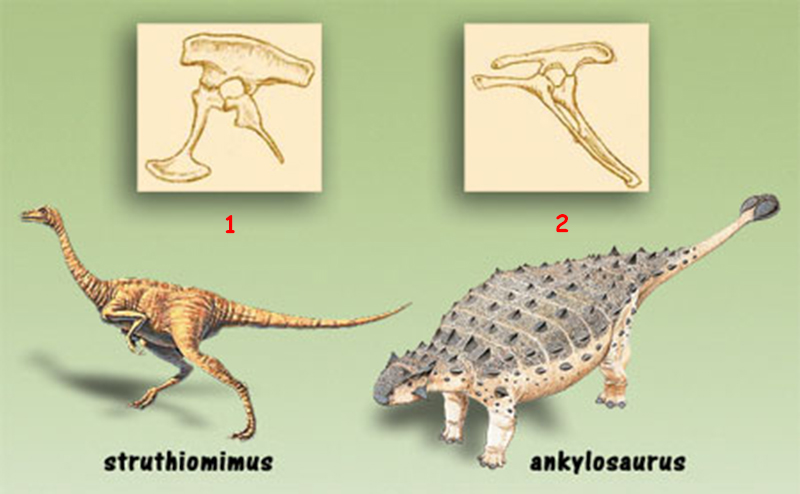 |
| 1. (left) An ornithischian (with bird-type hip bones) |
As with their structure and shape, the arrangement of bones in a reptile's body is also completely different from that in birds. It is quite impossible that a dinosaur's skeleton gradually transformed into an avian one suited to independent flight. First of all, the bones in both groups, dinosaurs and birds, are located where they are for a specific purpose. Their shapes too have been created according to need. Skull size, number of vertebrae, leg length, foldable wing bones, the breastbone necessary for flight—have all been created in line with birds' lifestyles. If there had been stage-by-stage mutations, as evolutionists claim, then we should come across a great many deformed skeletons. For example, in birds, one wing might be more developed than the other, or one arm might have been long and the other short. Balance might have been impaired by a large head on a small body, or toes pointing in the wrong direction might have been impaired its balance. Vertebrae might not have developed in the neck region, or might have been shaped in such a way as to put pressure on the nerves. The possibilities are endless. If a living thing's bones had developed by chance, then a great many such deficient or deformed anatomy should result.
Yet the layers of the Earth contain only flawless, regular fossils. This very absence of intermediate forms heads the list of subjects that evolutionists are reluctant to face. This clearly shows that living things did not evolve from one another, but were all created separately, each with their own unique structure.
The theory of reptiles evolving into birds will go down in history as an example of the magnitude of the errors that Darwinism can lead to. Alan Feduccia, for instance, says:
Well, I've studied bird skulls for 25 years and I don't see any similarities whatsoever. I just don't see it. . . The theropod origins of birds, in my opinion, will be the greatest embarrassment of paleontology of the 20th century. 43
Larry Martin, an expert in the anatomy of archaic birds at the University of Kansas, says:
To tell you the truth, if I had to support the dinosaur origin of birds with those characters, I'd be embarrassed every time I had to get up and talk about it. 44
The Unique Creation in the Avian Lung
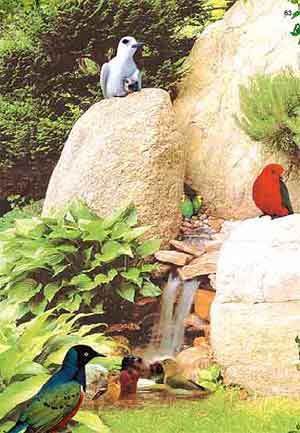 |
Another instance that invalidates the claim that birds evolved from reptiles is the unique creation of birds' lungs. The respiratory systems of terrestrial vertebrates and of birds work in completely different ways. Birds have a greater oxygen requirement than terrestrial animals and must transmit oxygen to their cells much faster. A terrestrial lung cannot, therefore, provide the level of oxygen that birds need. In fact, avian lungs have been specially created to supply the oxygen required for flight.
The lungs of vertebrate terrestrials have a two-directional structure. During inhalation, air proceeds down ever-branching passageways and ends up at tiny air sacs known as alveoli, where oxygen and carbon dioxide are exchanged. The CO2-laden air later returns by the same route, being expelled via the main bronchial tube.
But in a bird's lung, air always follows a one-way route. The lung's entrance and exit channels are different from one another, and the air always flows in one direction. The bird thus has uninterrupted access to the oxygen in the air.
Evolutionist author Henry Gee, editor of the international scientific journal Nature, says, "Birds have a remarkable breathing arrangement, in which the lungs form just one part of a one-way air handling system that incorporates large air spaces elsewhere in the body and even within the hollowed bones." 45
When the bird breathes, air flows from the windpipe both to the lung and to the rear air sacs. The air already present in the lung moves to the front air sac. When the bird exhales, clean air in the rear air sac flows to the lung and leaves the body via the front air sac. Both cycles, in inhalation and exhalation, must occur for every breath the bird takes. Instead of the alveoli in mammals' lungs, millions of tiny tubes extend all the way along the bird lung. This complex system of air sacs ensures that the air in the bird lung constantly flows in one direction, from back to front. Thus the direction of air flow is different from that in lizards or mammals, where air retraces its route during exhalation. The fact that air always flows in a single direction in birds allows them to use the air's oxygen more efficiently.
Birds' Bones Ideal Structure for Flight is one of the Proofs of Creation |
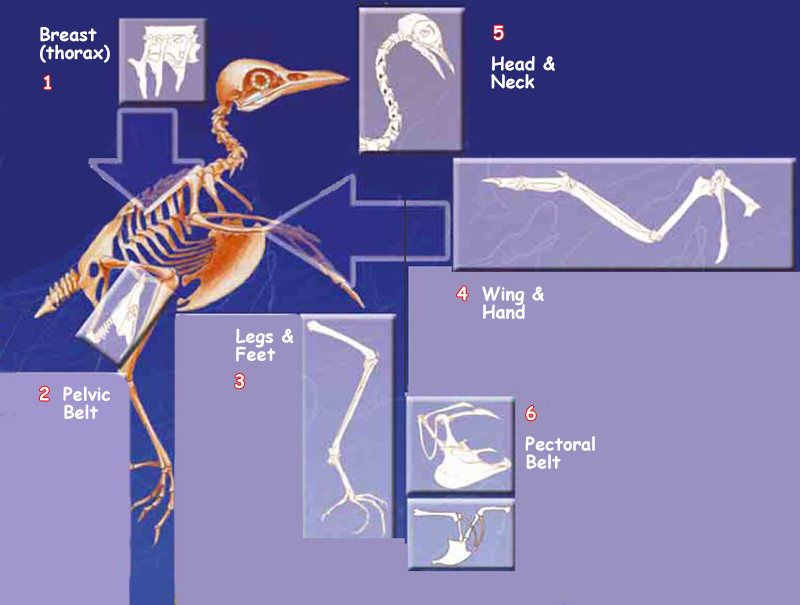 |
| 1. Breast (thorax) |
This efficient respiratory system unique to birds reduces the amount of energy they require to take off and remain aloft. Well-developed breast muscles, attached to the furcula bone—one of the structures essential to flight—add power to each wingbeat. The long wing feathers generate the necessary lift.
Birds have no diaphragm, and therefore make use of pressure differences in the air sacs within their bones to move the air in their lungs. Most birds have eight air sacs, functioning just like bellows to move air along their respiratory canal. Many air sacs extend into bones known as pneumatic bones. 46(Pneumatic means "working under pressure.") Thanks to this unique creation, birds' lungs remain always inflated, unlike those of mammals and reptiles, always providing them with fresh air. 47
The Avian Lung: One Example of Allah's Creative Artistry |
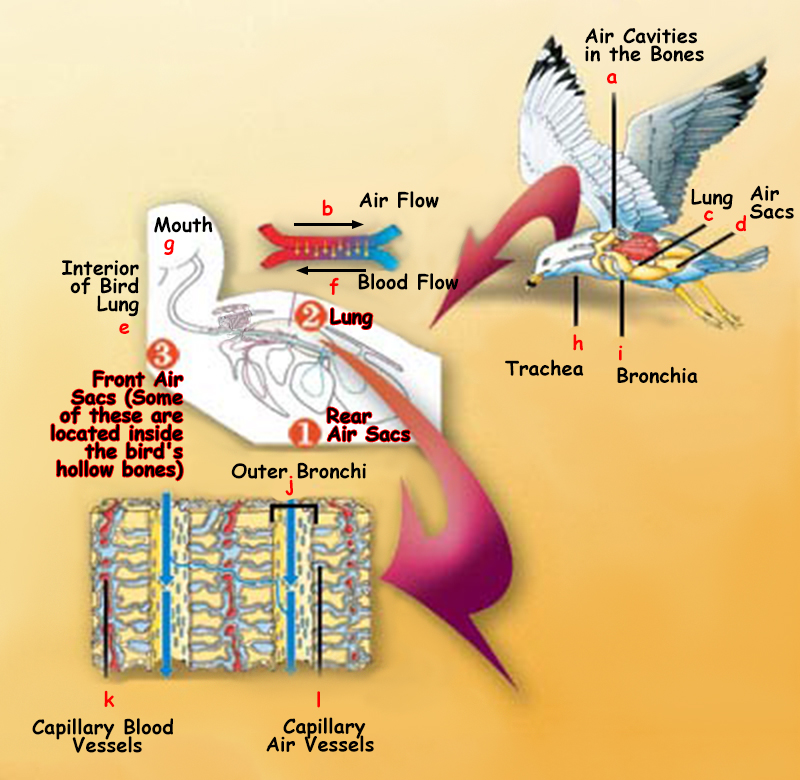 |
| When a bird inhales, air travels towards the rear air sacs(1). These then propel the air inside the lung (2), and air then flows from inside the lung to the front sacs (3). When the bird exhales, the front sacs expel the air. The avian lung does not expand and contract in the same way that reptile or mammalian lungs do. (In the diagram, blue represents low levels of oxygen and red, high oxygen content.) The blood that collects oxygen from the lung travels in the opposite direction from the flow of air. Thus the blood is carrying the lowest level of oxygen when exposed to the fresh air. |
This system in the avian lung structure is perfect for meeting high-energy requirements. Michael Denton, molecular biologist in the University of Otago in New Zealand says of this unique system:
In the case of birds, the major bronchi break down into tiny tubes which permeate the lung tissue. These so-called parabronchi eventually join up together again, forming a true circulatory system so that air flows in one direction through the lungs. . . . T]he structure of the lung in birds and the overall functioning of the respiratory system is quite unique. No lung in any other vertebrate species is known which in any way approaches the avian system. Moreover, it is identical in all essential details in birds as diverse as humming birds, ostriches and hawks. 48
The single-directional air canal is a unique structure, found only in birds. It is impossible for such a complex structure to have arisen in stages. The single-direction air canal system and lungs must both exist in completed form if the bird is to survive. Any living thing whose lungs do not function perfectly cannot live very long.
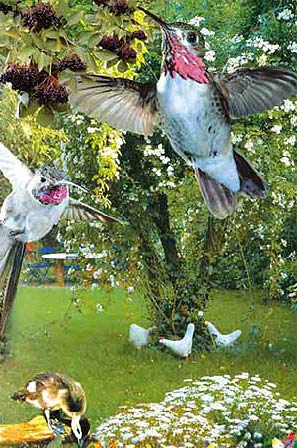 |
Michael Denton sets out the impossibility of an evolutionary explanation for the origin of the bird lung:
Just how such an utterly different respiratory system could have evolved gradually from the standard vertebrate design is fantastically difficult to envisage, especially bearing in mind that the maintenance of respiratory function is absolutely vital to the life of an organism to the extent that the slightest malfunction leads to death within minutes. Just as the feather cannot function as an organ of flight until the hooks and barbules are co-adapted to fit together perfectly, so the avian lung cannot function as an organ of respiration until the parabronchi system which permeates it and the air sac system which guarantees the parabronchi their air supply are both highly developed and able to function together in a perfectly integrated manner. 49
In short, none of the alleged intermediate stages between the two types of lung are suited to a creature's survival. Since any lungs whose structural anatomy remained incomplete could not function at all, such a possibility is out of question. No living species has the time to wait for the changes necessary for such a transition to take place. Unless a bird possesses one type of lung or the other in full working order, it will die.
This fact is sufficient to show that this plumonary anatomy, unique to birds, cannot have emerged through chance mechanisms such as natural selection. The avian lung is just one of the countless proofs that living things were created by Allah.
According to Michael Denton, lungs remaining functional throughout the passage, via minute changes, from the reptile version to the avian version, with the animals enjoying an advantage at every step is no more than a work of the imagination. Indeed, according to evolutionist claims, the transition from the reptile to the bird lung must have begun with a weak quadruped whose diaphragm was incomplete, and natural selection should have eliminated such a creature.
In an interview, Denton stated that such a passage cannot have taken place and criticizes the claims made by Darwinism in terms of the avian lung:
Well, the basic pattern it fails to explain is the apparent uniqueness and isolation of major types of organisms. My fundamental problem with the theory is that there are so many highly complicated organs, systems and structures, from the nature of the lung of a bird, to the eye of the rock lobster, for which I cannot conceive of how these things have come about in terms of a gradual accumulation of random changes.
It strikes me as being a flagrant denial of common sense to swallow that all these things were built up by accumulative small random changes. This is simply a nonsensical claim, especially for the great majority of cases, where nobody can think of any credible explanation of how it came about. And this is a very profound question which everybody skirts, everybody brushes over, everybody tries to sweep under the carpet.
The fact is that the majority of these complex adaptations in nature cannot be adequately explained by a series of intermediate forms. And this is a fundamental problem. Common sense tells me there must be something wrong. 50
As his statements show, there can be no question of an evolutionary link between the two-directional reptile lung and the one-directional bird lung. It's impossible to establish any transitional model between these two pulmonary structures. A terrestrial animal must constantly breathe to survive, and any radical change to its lungs will inevitably end in death in a matter of minutes. Yet according to evolution, this change must have occurred over millions of years
Another point is that reptiles have a diaphragm-based respiratory system, whereas birds do not. These different structures again repudiate claims of the one type evolving into the other.
John Ruben, an authority on respiratory physiology, comments:
The earliest stages in the derivation of the avian abdominal air sac system from a diaphragm-ventilating ancestor would have necessitated selection for a diaphragmatic hernia in taxa transitional between theropods and birds. Such a debilitating condition would have immediately compromised the entire pulmonary ventilatory apparatus and seems unlikely to have been of any selective advantage. 51
Another feature that challenges the evolution of the avian lung is its special structure which, when deprived of air, faces the danger of collapsing. Michael Denton explains:
Just how such a different respiratory system could have evolved gradually from the standard vertebrate design without some sort of direction is, again, very difficult to envisage, especially bearing in mind that the maintenance of respiratory function is absolutely vital to the life of the organism. Moreover, the unique function and form of the avian lung necessitates a number of additional unique adaptations during avian development. As H. R. Dunker, one of the world's authorities in this field, explains, because first, the avian lung is fixed rigidly to the body wall and cannot therefore expand in volume and, second, because of the small diameter of the lung capillaries and the resulting high surface tension of any liquid within them, the avian lung cannot be inflated out of a collapsed state, as happens in all other vertebrates after birth. The air capillaries are never collapsed as are the alveoli of other vertebrate species; rather, as they grow into the lung tissue, the parabronchi are from the beginning open tubes filled with either air or fluid. 52
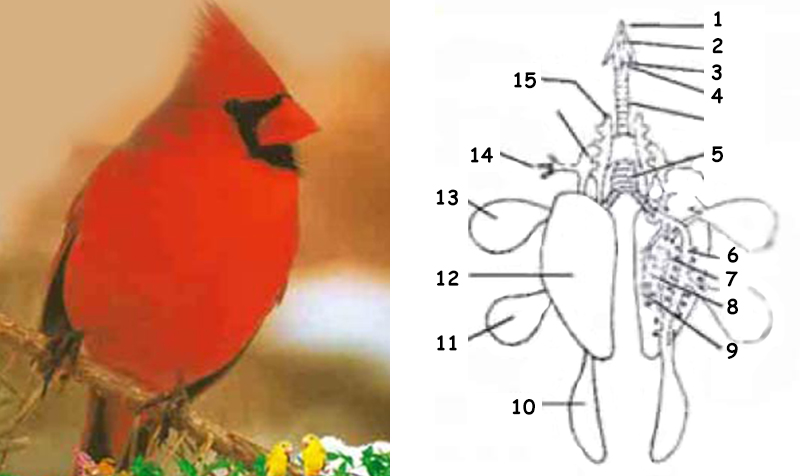 | ||
| 1. Beak, | 6. Intermediate central bronchig | 11. Rear breast sac |
| The respiratory system in birds is a marvel of engineering, too perfect to be the result of chance— which clearly invalidates evolutionist claims. | ||
Avian lung canals are so narrow that the air sacs cannot be inflated and deflated like those in other vertebrates. If a bird's lung ever deflates, the bird will be unable to draw air into it again, or will experience enormous difficulty in doing so. The air sacs in the lung therefore ensure a constant flow of oxygen and protect the lung against deflation.
Of course this system—totally different from the lungs of reptiles and other vertebrates, and based on the most sensitive balances—cannot have developed in stages through random mutations, as the theory of evolution claims. Denton states that this structure of the avian lung invalidates Darwinism:
The avian lung brings us very close to answering Darwin's challenge: "If it could be demonstrated that any complex organ existed, which could not possibly have been formed by numerous, successive, slight modifications, my theory would absolutely break down." 53
When we look at the bird lung, we see that it cannot have come into being through a number of small changes. This means that Darwin's theory, in his own words, will absolutely break down.
John Ruben, an expert in evolutionary respiratory physiology at Oregon State University, has this to say:
Recently, conventional wisdom has held that birds are direct descendants of theropod dinosaurs. However the apparently steadfast maintenance of hepatic-piston diaphragmatic lung ventilation in theropods throughout the Mesozoic poses fundamental problems for such a relationship. The earliest stages in the derivation of the avian abdominal air sac system from a diaphragmatic-ventilating ancestor would have necessitated selection for a diaphragmatic hernia [or hole] in taxa transitional between theropod and birds. Such a debilitating condition would have immediately compromised the entire pulmonary ventilatory apparatus and seems unlikely to have been of any selective advantage. 54
In short, any direct transition from the reptile lung to the bird lung is impossible. This important scientific evidence demonstrates the groundlessness of the "avian evolution" thesis and shows that our Almighty Lord created birds together with their unique physical designs.
Evolutionists Ignore the Evidence Against Their Theory
Most evolutionist scientists still believe that birds evolved from dinosaurs. One consequence of this widespread view is that they ignore all the evidence to the contrary.
One example of this is the research by respiratory physiology expert John Ruben at the Oregon State University in Corvallis. A group under Ruben's leadership examined the fossil design of the internal organs of Sinosauropteryx, a small, 120-million-year-old carnivore, and found that theropods resembled crocodiles rather than birds. Says Ruben:
I realized that here was the first evidence in the soft tissue that theropods had the same kind of compartmentalization of lungs, liver, and intestines that you would find in a crocodile—and not in a bird.1
Theropods have two main cavities: the chest cavity including the lung, liver and heart; and the abdominal cavity containing the other organs. As in the crocodile, these are completely separated from one another by the diaphragm. In birds, there is no such separation. The function of this division in crocodiles is to prevent air leaking between the cavities. When the diaphragm muscles contract, they retract the liver and equalize air pressure in the chest cavity by allowing the bellow-type lungs to fill with air. .
At the same time, Ruben also showed that theropods and crocodiles possessed different hip structures, attached to muscles and which helped the bellow-type lungs fill with air. As a result of these findings, Ruben states:
It's pretty solid evidence that theropods could not have had a modern, high-performance avian-style lung... and were stuck with an unmodified, bellows like lung.2
In an interview, Ruben stated that the pulmonary system in birds could not have evolved from dinosaurs' lungs.
In another possible similarity with crocodiles, scientists found evidence in the infant dinosaur of a specialized breathing device called a hepatic piston.3
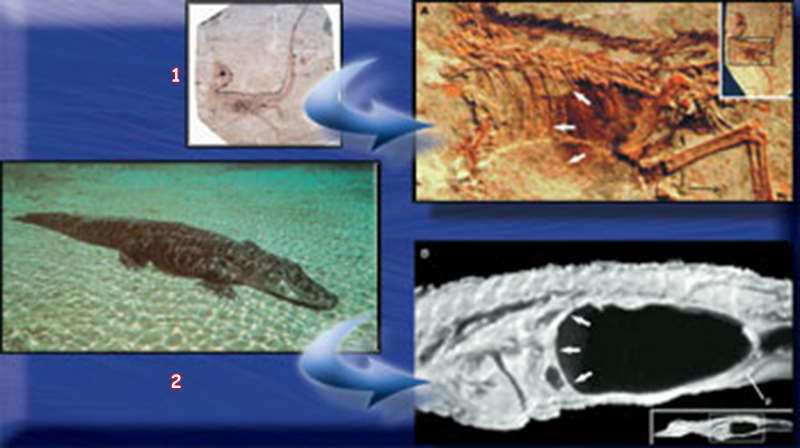 |
| 1. Scientists studying the internal organs of Sinosauropteryx, a 120- million-year-old small carnivorous dinosaur, revealed that theropods resembled crocodiles more closely than birds. |
In this way, Ruben and his team once again showed that bellow-type lungs could not have evolved into the high-performance lungs in birds.4 An article published in Science magazine, "Lung Fossils Suggest Dinos Breathed in Cold Blood," refers to his research:
Ruben and his graduate students sectioned crocodiles and other reptiles and found that their lung structures resembled the images of several flattened fossil dinosaurs from China. Ruben uses this lung evidence to argue not only that dinosaurs were incapable of the high rates of gas exchange needed for warm-bloodedness, but also that their bellows-like lungs could not have evolved into the high-performance lungs of modern birds. Thus, he challenges two of the reigning hypotheses concerning dinosaurs: that they were warm-blooded and that they gave rise to birds... But while many dinosaur experts say they welcome Ruben's novel approach, few are willing to embrace his conclusions so far. 5
In the view of some, Ruben's report is a "one-two punch to the dinosaur origins of birds hypothesis."6 It is striking however, that the proponents of dinosaurs evolving into birds do not include this evidence against their theory in their calculations. Supporters of the dino-bird thesis cannot offer any consistent explanation of how the rather complex avian lung, different from that in all other living vertebrates, came into be. They close their eyes to any contradictory evidence..
In addition, Ruben examined under ultraviolet light the species Scypionyx samniticus, a small carnivore whose organs are among some of the best preserved among known dinosaurs...The arrangement of certain internal organs of this species, was revealed thanks to this ultraviolet light. The main outlines of the animal's intestines, liver, windpipe (trachea) and muscles were determined. Although the fossil is two-dimensional, Ruben says:
Nothing is displaced ...all [organs] are preserved in relation to each other.7
In this creature, a muscle that extends from the pubis to the liver helps the liver to move backwards and forwards like a piston, thus enabling the lung in modern-day crocodiles to expand and contract. The diaphragm, a layer of tissue impermeable to air, separates the liver and lungs. According to Ruben, the existence in dinosaurs of this structure known as the hepatic piston diaphragm totally eliminates the possibility that they once breathed by the same means as used in the avian lung. Ruben and his colleagues concluded that the arrangement of the internal organs in dinosaurs in no way resembled that in birds, and that these creatures were cold-blooded..8
Birds and Dinosaurs Have Very Differend Anatomical Structures |
 |
| 1. lung |
The Kansas University paleontologist Larry Martin, who reviewed Ruben and his team's research, states:
There's actually no way they could be wrong about this. The Scipionyx specimen has the best preservation ever seen. It's one of the biggest discoveries of this decade. It tells us more about dinosaurs than any other specimen... The positions of the dinosaur's windpipe and colon serve as independent checks that the animal did not have a bird's breathing apparatus.9
Coming out to oppose the view that birds are descended from dinosaurs, Larry Martin summarizes the issue:
Support for the hot-blooded dinosaur hypothesis now has the rigidity of a marshmallow.10
According to Peter Dodson, a paleontologist from Pennsylvania University in Philadelphia, Ruben's analysis is;
Another nail in the coffin of the warm-blooded dinosaur theory.11
Ruben also emphasizes that the absence of the bird-type lung in dinosaurs casts a shadow over the idea that birds are descended from them.Interestingly, however, the findings from all this research were not welcomed, because they clashed with the theory of evolution. In the same way that evolutionists offer no evidence to the contrary, they ignore criticism and seek to keep their theory alive through high-profile, sensational media reports and methods of suggestion. This reveals the dogmatism of the evolutionist perspective and their biased interpretation of fossils.
Footnotes 1
1. Ann Gibbons, "Lung Fossils Suggest Dinos Breathed in Cold Blood," Science, Vol. 278, No. 5341, 14 November 1997, pp. 1229-1230. 
3. Malcolm W. Browne, "Turning Dinosaur Theory on its Paleobiological Tail," The New York Times, 26 January 1999, Science Desk . 
7. "Turbocharged dinosaur," BBC News, 21 January 1999; http://news.bbc.co.uk/2/hi/science/nature/259902.stm 
8. John A. Ruben, Cristiano Dal Sasso, Nicholas R. Geist, Willem J. Hillenius, Terry D. Jones, Marco Signore, "Pulmonary Function and Metabolic Physiology of Theropod Dinosaurs," Science, 22 January 1999, pp. 514-516.. 
9. Malcolm W. Browne, The New York Times, 26 January 1999.. 
The Peacock is an Example of Allah's Matchless Creative Artistry
Stuart Burgess, an assistant professor of engineering design at Bristol University in England, revealed the extraordinary nature of the peacock feather in a most striking way and concluded that this structure could not be explained in terms of Darwin's theory of "sexual selection."
With its large tail feathers with their vivid hues and unique patterns, the peacock possesses an extraordinary beauty. One feature of these stunning iridescent colors is that they change according to the angle one views them from. These are created not thanks to pigments (the substance that gives color to feathers ), but to an optical effect in the micro-hairs known as the "thin film."
The thin film effect that appears in the micro-hairs—the smallest structures in bird feathers that can be seen only under a microscope—takes place in three keratin layers.
The transparent keratin layers refract light, while retaining some components of that light. The fact that the soft inner part is brown prevents light passing through and disappearing by providing a dark background. The reflected light can thus give rise to colors. The thin film effect takes place in the three layers at the same time, producing different shades. It is possible for the keratin layers to produce a specific color only thanks to their being very thin, just 1/20,000 of a millimeter (0.000,001,969 of an inch), the ideal thickness for production of the most bright colors. The thickness of each layer must not exceed the wavelength of visible light. The extraordinary vividness of the eye patterns in the peacock's tail stems from this unique color-production mechanism.1
The eye shape at the end of each feather emerges through a combination of thousands of micro-hairs. Although they are independent of one another, thousands of neighboring micro-hairs produce this pattern. Were they arranged at random and in an unordered manner, they could not produce the geometric shapes based on mathematical formulae not detailed here. The odds of this shape arising by chance are as slim as that of the flowers in a garden combining to produce the same pattern.
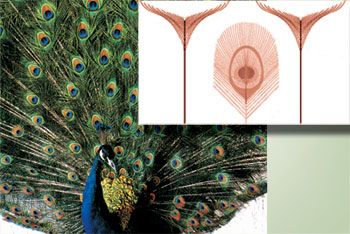 |
| The peacock's tail, large feathers, bright color and unique patterns are extraordinarily beautiful. T- and eye-shaped patterns are arranged in a fan-like shape. The feathers' showy appearance is based on a microscopic level of complexity. |
During courtship, an adult male peacock produces a magnificent fan as it displays its tail feathers. An adult peacock's approximately 200 tail feathers are replaced each year. Around 170 of these are the ones forming the pattern of an eye, while the rest form a T shape. At the microscopic level, the T and eye feathers can be seen to have a very complex structure. Each of the eyes can be seen, because the short feathers have been located toward the front of the tail and the longer feathers at the back.
One reason why the feathery display appears so attractive is that they constitute a semi-circular fan with an angle greater than 180 degrees. This fan is very regular, since every feather's axis emerges from a common geometric centre. The angles with which the feathers exit the center is also specific.
That the information determining all the structures in the feathers is concealed in DNA once again emphasizes the extraordinary nature of creation. The number and thickness of the keratin layers, the number of micro-hairs, the brown background, the distance between the feathers—all these factors are produced according to data in the DNA. This peerless beauty cannot possibly have emerged through random mutations, as evolutionists would have us believe.
Right from the outset, this fact has represented a major predicament for the theory of evolution. Darwin, who endeavored to account for the signs of creation in living things in terms of blind coincidence, made the following confession regarding peacock feathers in a letter he wrote to his friend Asa Gray on 3 April, 1860:
The sight of a feather in a peacock's tail, whenever I gaze at it, makes me sick! 2
This certainly demonstrates Darwin's biased point of view.
The beauty in the peacock tail has nothing to do with its function. This attribute of the peacock is a clear indication of creation. When one sees beauty in a human design, one immediately realizes that it must have a designer. For example, in addition to imparting order and functionality to a garden, a landscape architect also brings to it beauty and attractiveness—clear signs that this garden was the work of a designer. Every detail the architect adds to its beauty is further proof that the garden has not been arranged at random.
The beauty in peacock feathers, which display all the fine detail of optical science, are examples of aesthetic marvels that reveal the existence of their Creator, Our Lord.
Every detail in the peacock feather, which we have reviewed here only in broadest terms, has the appropriate location, shape, color and structure for a specific purpose. That purpose displays to us Allah's artistry, introduces us to His knowledge in the details and that Allah possesses all the power necessary to create matchless beauties that delight human beings.
In one verse of the Qur'an, people who fear Allah and who are able to comprehend such concepts by drawing attention to the beauty in living things are described as "possessing knowledge":
And humanity and beasts and livestock are likewise of varying colors. Only those of His servants with knowledge have fear of Allah. Allah is Almighty, Ever-Forgiving.(Surah Fatir, 28)
Footnotes 2
1. Stuart Burgess, "The beauty of the peacock tail and the problems with the theory of sexual selection," The In-Depth Journal of Creation, Vol. 15, No. 2, 2001, pp. 94-102.The in Depth Journal of Creation, vol. 15, no.2, 2001, ss. 94-102. 
2. Francis Darwin, Letter to Asa Gray, 3 April 1860, The Life and Letters of Charles Darwin, London: John Murray, Vol. 2, 1887, p. 296. 
The Impossibility of Reptiles' Scales Turning Into Bird Feathers
The origin of birds has always represented a major difficulty for Darwinism. Even today, there is still no unanimity on the subject among evolutionists. One of the dilemmas facing them in this regard is the origin of birds' feathers, which possess a complex structure essential for flight, and which is present only in birds.
Many evolutionists maintain that over millions of years, dinosaur scales gradually developed into feathers by means of mutations and natural selection. However, no evidence indicates any such transition from scales to feathers, which is physiologically and anatomically impossible. Aware of this, evolutionists gloss over the matter with superficial explanations. In one of his books, the atheist and evolutionist Richard Dawkins makes do with a crude explanation consisting of single sentence: "Feathers are modified reptilian scales." 55
Let us now look at the impossibility of these claims in detail.
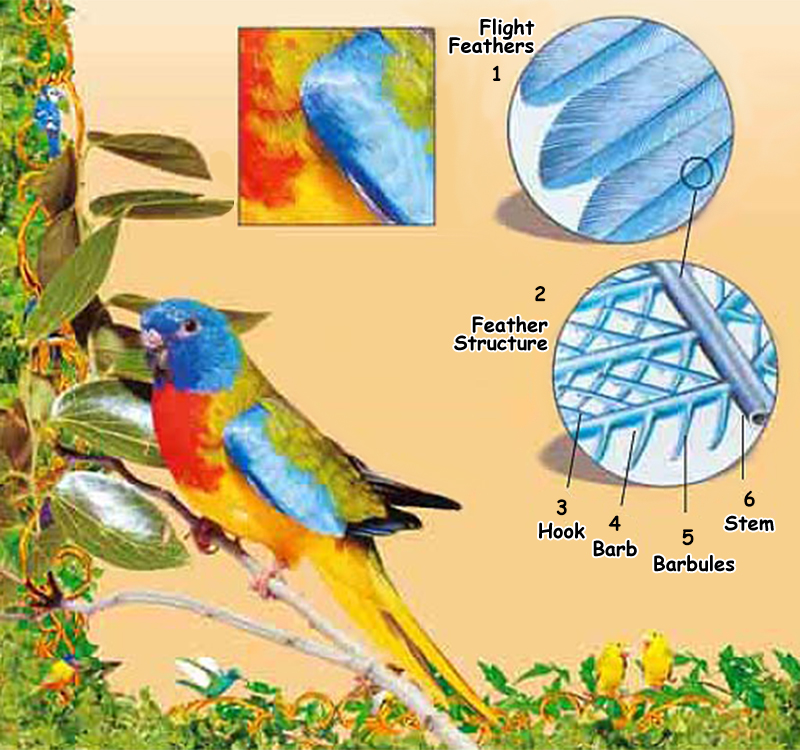 |
| Flying bird feathers consist of barbs emerging from a single stem, barbules and hooks. The barbules at the edge are literally attached to one another by the hooks. This special creation in the feathers, held together as if by a zipper, once again disproves claims of evolution based on chance. |
Reptile scales and bird feathers are very different structures:
It's perfectly logical that evolutionists cannot supply any reasonable explanation of the origin of feathers, because reptile scales and bird feathers are entirely different structures. A. H. Brush, a professor of physiology and neurobiology from the University of Connecticut, sets out the structural difference between the two:
At the morphological level, feathers are traditionally considered homologous with reptilian scales. However, in development, morphogenesis, gene structure, protein shape and sequence, and filament formation and structure, feathers are different. 56
Scales are folds in the skin, consisting of flat, horn-like layers. Overlapping one another like roofing tiles, they serve to keep water off, permit the animal's skin to move easily and conserve moisture and body heat. Feathers, on the other hand, are light, strong and aerodynamic forms—highly complex structures unique to birds. They consist of a central stalk, from which sprout hairs lined with microscopic barbs, barbules, and hooks. The barbs are bound together at their edges with tiny hooks, attached in such a way as to keep the feather surface flat, powerful and flexible. At the same time, this structure makes the feather impermeable to water, and thanks to the hooks, every hair is attached to its neighbor as if with a zipper.
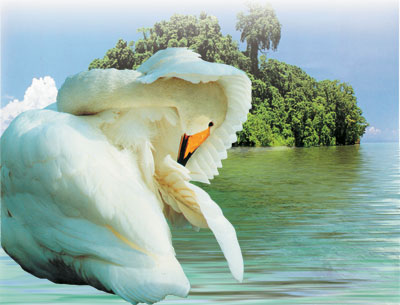 |
| To survive, birds must constantly keep their feathers clean and groomed. They use oil glands at the bottom of their tails to maintain their feathers. Taking up some of this oil on their beaks, they clean and polish their feathers. In swimming birds, this oil prevents water from soaking the feather when they are under water or in the rain. Birds also prevent their body temperatures from cooling by puffing up their feathers. In warm temperatures, they cool their bodies by holding their feathers close to their bodies. The fact that feathers have been created to have so many functions in response to outside requirements, is another example of Allah's mercy toward living things.. |
A crane's feather, for example, has some 650 tiny barbs extending along both sides of the main stem. In each one of these, there are 600 contraposed micro-hairs, attached to one another with 390 tiny hooks. The hooks bind them together, rather like the teeth of a zipper. If these are broken apart for any reason, the bird can simply shake itself or preen itself with its beak for them to resume their previous continuous plane.
The ornithologist Alan Feduccia describes this special structure:
They are lightweight, strong, aerodynamically shaped, and have an intricate structure of barbs and hooks. This structure makes them waterproof, and a quick preen with the beak with the bill will cause flattened feathers to snap into fully aerodynamic shape again. 57
The belief that feathers' complex structure evolved from reptiles' scales by means of random mutations is nothing more than dogma. Ernst Mayr, one of the founders of neo-Darwinism, made the following admission many years ago:
It is a considerable strain on one's credulity to assume that finely balanced systems such as certain sense organs (the eye of vertebrates, or the bird'' feather) could be improved by random mutations. 58
Bird feathers and reptile scales develop very differently:
Feathers do not differ from scales only in structural terms, but in their developmental paths also. Feather development is an exceedingly complex process. In contrast to scales, feathers grow out of tiny sacs called follicles, just like hairs do. Yet a hair has a much simpler structure than that of a feather. The growing feather is protected by a sheath and forms around a cone-shaped nucleus. The cells that will constitute the feather also develop through highly complex physiological processes. Once the cells have formed, they migrate away from one another so as to form the complex sequences in the hooks and barbs at the feather's edge. 59
Moreover, scales and feathers each grow out of different epidermal (skin) layers. Feathers, with their basically protein structure, are made of keratin, a strong, hard substance that forms when old cells in the subdermal layers die and are replaced by younger cells. However, feather proteins (b-keratins) are biochemically different from skin and scale proteins (a-keratins).
From these differences, A. H. Brush concludes that:
At the morphological level, feathers are traditionally considered homologous with reptilian scales. However, in development, morphogenesis, gene structure, protein shape and sequence, and filament formation and structure, feathers are different. 60
An interview by Dr. Carl Wieland with Dr. David Menton of the Washington University Medical Faculty covered the impossibility of reptile scales evolving into bird feathers:
Dr. Carl Wieland:
...Of course, evolutionists have long argued that feathers evolved from reptile scales and are thus fundamentally the same structure—very similar.
Dr. David Menton:
Yes, so I became interested in comparing them myself. I had a laboratory technician at the time who had a pet boa constrictor, so I took a look at some of its scales from shed skin. I was amused that they were, of course, not even the slightest bit similar to feathers, as these photographs show. The only similarity is that they are both made of the protein keratin—like hair, nails and our skin. It's quite different. The most fundamental difference is that the feather grows out of a follicle, a tubular down-growth of the epidermis that protrudes deeply into the skin, all the way down to underlying bone in the case of primary feathers. And this tube of specialized living skin produces the feather inside of itself from a growth matrix at the very bottom.
The reptilian scale has absolutely nothing to do with follicles. All of the scales can shed as a sheet because they're nothing but folds in the epidermis, like fabric folded over on itself, whereas feathers would have to come out of their own follicle. So, if evolutionists really wanted to make a case, they could argue that feathers evolved from hair, or vice versa.
Now, of course, that wouldn't fit the evolutionary belief that mammals and birds evolved independently from reptiles. 61
No matter how they may combine, it is impossible for unconscious cells to know how to adopt an order to enable a bird to fly. No one with common sense could ever accept that chance mechanisms—natural selection and mutation—could design the feather's structure, so ideally suited to flight. With their organs and systems created for them by our Almighty Lord, living things possess various perfections, reflecting proof of our Lord's infinite reason and knowledge.
In one verse Allah reveals:
What is in the heavens and in the Earth belongs to Allah. Allah encompasses all things..(Surat an-Nisa', 126)
Feathers Grow in a Very Differend Way Than scales do Evolution Between Two Forms is Impossible |
| Feathers do not differ from scales only in terms of structure, but also in the way they develop. Feathers grow by keratosinites (cells that form keratin) increasing and diverging from one another. When these keratin-producing cells in the epidermis (outer skin) layer die, they leave behind an accumulation of keratins— strong but flexible protein fibers. Feathers develop from beta-keratins. The sheath outside a growing feather is made out of softer alpha-keratin. Feathers arise from cavities under the skin known as papillae and cover almost a bird's entire body. |
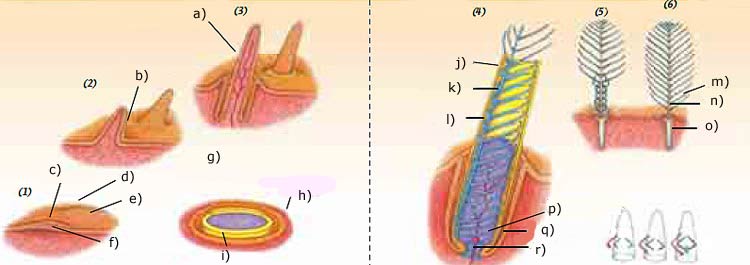 |
| a) The would-be feather, b) The would-be feather, c) Cell densification, d) Plaque (placode), e) Epidermis (outer skin), f) Dermis (lower skin), g) Follicle (small sac), h) Inner skin of the sac, i) Outer sac skin, j) Vane sheath, k) The back of the shaft, l) Feather back, m) Vane, n) Shaft, o) Quill, p) Newly emerging vane sheath, q) Body surrounding the sac, r) Artery |
There is not a single trace of the intermediate forms that evolutionists claim should frequently be encountered:
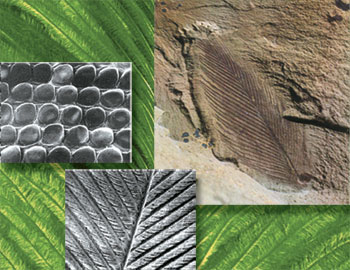 |
| The enormous differences between bird feathers and reptile scales—and the feather's exceedingly complex structure—utterly invalidate the claim that feathers evolved from scales. According to evolutionist claims, the fossil record should contain a great number of intermediate stages between reptiles' scales and birds' feathers. In the fossil record, we do find reptile scales, bird feathers and skin and mammalian hairs. But no part-scale, part-feather structures indicating any gradual transition to bird feathers have ever been encountered in any fossil, much less in any living vertebrate. |
In suggesting that feathers evolved from scales, evolutionists cannot point to any intermediate form in the fossil record that indicates feathers' stage-by-stage development. Yet there are fundamental morphological differences between the two, meaning there should be a great many such intermediate forms. Yet in the fossil record, reptile scales, bird feathers, skin and mammal fur all appear perfectly formed. Not a single fossil exists pointing to a transition to the avian feather, as is admitted in Nature magazine, an evolutionist publication:
Feathers are complex structures. Their abrupt appearance in the bird fossil record has been difficult to explain, mainly because no intermediate structures are preserved in the related theropod taxa. 62
Some forty-five years ago, the evolutionist W. E. Swinton referred to the lack of evidence in the chapter titled "The Origin of Birds" in his book Biology and Comparative Physiology of Birds:
The [evolutionary] origin of birds is largely a matter of deduction. There is no fossil evidence of the stages through which the remarkable change from reptile to bird was achieved. 63
The situation remains exactly the same today. This is made clear by the statement by an evolutionary biologist from Columbia University: ". . . we lack completely fossils of all intermediate stages between reptilian scales and the most primitive feather." 64
The evolutionist paleontologist Barbara J. Stahl makes this confession:
How [feathers] arose initially, presumably from reptiles scales, defies analysis. . . It seems, from the complex construction of feathers, that their evolution from reptilian scales would have required an immense period of time and involved a series of intermediate structures. So far, the fossil record does not bear out that supposition.65
In another statement, she refers to the intermediate-form impasse:
No fossil structure transitional between scale and feather is known. . . and recent investigators are unwilling to found a theory on pure speculation.66
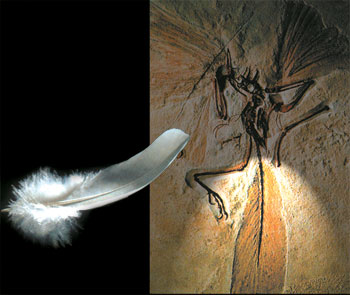 |
| An Archaeopteryx fossil found near Langenaltheim in 1861, known in the literature as "the London specimen. This fossil was announced by the German paleontologist Hermann von Meyer and was later sold to the London Museum. The fossil's feathers have the same structure as present- day flying bird feathers. Archaeopteryx fossils reveal the existence, millions of years ago, of birds with complex feather structures and the ability to fly. |
Some evolutionists seek to gloss over the matter by saying that since birds have hollow bones, they left no fossils behind. That, however, is very definitely untrue. Under certain conditions—for example, around lakes, in watery inland regions and those close to the sea—very good bird and feather fossils are frequently discovered. Thousands of fossil birds have been discovered to date, and all possess perfectly formed feather structures. Just as there are no half-scale, half-feather in the fossil record, no structure resembling a feather less developed than present-day specimens has ever been found.
In an American Zoology article, Larry Martin and S. A. Czerkas write, "The oldest known feathers ...are already modern in form and microscopic detail."67
The anatomist David Mention also touches on the subject:
There are no examples of living or fossil scales that even remotely resemble a feather. Archaeopteryx has complete feathers like modern birds.68
Specimens of Archaeopteryx, the oldest known bird, have been perfectly preserved. An analysis of its 150-million-year-old feathers has revealed that every detail is identical to present-day specimens.69 Back in 1910, the zoologist W. P. Pycraft stated that the Archaeopteryx feather was no different from fully developed modern feathers.70 Other Archaeopteryx fossils discovered since that time have in no way altered that fact. There are many well-preserved feathers in amber dating back to the late Mesozoic Period (251 to 65 million years ago). In addition, analysis of the many modern discoveries of dinosaur skin has revealed that "The skin of a wide variety of dinosaurs ... is unlikely to represent a predecessor to a feather-bearing integument." 71
In their Scientific American article, "Which Came First, the Feather or the Bird?" Richard O. Prum and Alan H. Bush wrote:
Plymouth Rock Hen |
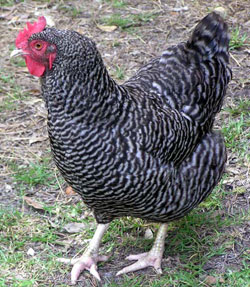 |
| Many species have thousands of feathers: The Plymouth Rock hen has approximately 8,000, and the Whistling Swan 25,000. Even a small bird such as the goldcrest may have more than 1,000 feathers.(1) The fact that each one of these thousands of feathers has a separate function and assumes the right shape, size and angle cannot be the result of chance. Feathers arranged for flight are proof of creation and display Allah's dominion over living things. |
| Each of the feathers in the various parts of a bird's body serve a separate function. The feathers on the stomach, wings and tail all possess very different properties. Together, the large tail feathers act as a brake and rudder. Meanwhile, the wing feathers widen the wing's surface area by opening up and enhancing the lift. During the downbeat, the wingfeathers draw closer to one another, preventing the air from leaking between them. On the upbeat, the feathers open out, permitting air to pass between them. |
Progress in solving the particularly puzzling origin of feathers has also been hampered by what now appear to be false leads, such as the assumption that the primitive feather evolved by elongation and division of the reptilian scale, and speculations that feathers evolved for a specific function, such as flight. A lack of primitive fossil feathers hindered progress as well. For may years, the earliest bird fossil has been Archæopteryx lithografica, which lived in the Late Jurassic period (about 148 million years ago). But Archaeopteryx offers no new insights on how feathers evolved, because its own feathers are nearly indistinguishable from those of today's birds. 72
Evolutionists' biased attitudes towards the question of the origin of bird feathers led to conflicting theories. 73 It was claimed that reptile scale gradually lengthened, developed fringes, and assumed a form capable of bearing a bird in such a way as to facilitate flight. 74It's of course impossible for an unconscious scale to decide to lengthen itself and then change form so as to achieve the structure of the avian feather. It's even more impossible for all the scales on a reptile's body to make such a decision and give rise to a marvel of creation that astounds scientists. Indeed, evolutionists have no evidence to support their scenarios, which are simply based on imagination.
The fossil record refutes feathered dinosaur claims:
To date, there has been speculation regarding "feathered dinosaurs," although detailed analysis has refuted all of it. In an article titled, "Why Dinosaurs Lacked Feathers," the eminent ornithologist Alan Feduccia writes:
Feathers are features unique to birds, and there are no known intermediate structures between reptilian scales and feathers. Notwithstanding speculations on the nature of the elongated scales found on such forms as Longisquama ...as being featherlike structures, there is simply no demonstrable evidence that they in fact are. 75
All the fossils proposed as representing feathered dinosaurs over the last ten years are in fact debatable. Detailed examination has shown that the structures portrayed as feathers are actually collagen fibers (protein connective tissue) from under the skin. 76 Alan Brush, an expert on bird feathers from Connecticut University, has indicated that these lack many of the structures found in modern bird feathers. 77
Speculation regarding the remains in question stems from evolutionist prejudice. As Alan Feduccia says, "Many dinosaurs have been portrayed with a coating of aerodynamic contour feathers with absolutely no documentation." 78 However, it has emerged that the specimens sometimes depicted as feathered dinosaurs were not really such, and that such inference resulted from biased interpretation. (For detail, see the sections "The False Fossil Archaeoraptor: An Example of Evolutionist Fanaticism and Imaginary Dinosaur-Bird Links").
Alan Feduccia summarizes the matter in these words:
Finally, no feathered dinosaur has ever been found, although many dinosaur mummies with well-preserved skin are known from diverse localities. 79
Even if feathered dinosaurs had existed, they would provide no evidence for dino-bird evolution, because the feathers claimed for such dinosaurs bear no resemblance to the unique structure of bird feathers. Moreover, in addition to their complex designs, bird feathers also have very different biochemical structures. No structures resembling bird feathers are to be found in other creatures. According to the Connecticut University professor of physiology and neurobiology Alan H. Brush, "the protein structure of bird feathers is unique among vertebrates." 80
Is He Who creates like him who does not cerate? So will you not pay heed? If you tried to number Allah's blessing, you could never count them. Allah is Ever-Forgiving, Most Merciful. (Surat an-Nahl, 17-18)
The Claim That Feathers First Developed for Insulation is Groundless
Some evolutionists maintain that dinosaurs developed feathers for insulation and later arranged them for the purpose of flight. Other claims include that dinosaurs developed feathers to repel water, to collect excess sulphur waste, to be used as a thermal shield, or to achieve higher running speeds. Yet none of these hypotheses has any validity in explaining birds' aerodynamic structures.
Richard O. Prum of Kansas University writes a comprehensive criticism of these theories:
Current functional theories are insufficient to explain the origin and diversification of feathers and are a hindrance to evaluating. 81
In suggesting that feathers developed for reasons other than flight, they cannot explain how scales on the skin developed into a wholly different structure such as feathers. As you have seen, no fossils have ever been found to show scales developing into feathers, nor forearms into wings. 82
Alan Feduccia, the best known critic of the theory that birds are descended from dinosaurs, says that he has seen no evidence that dinosaurs had feathers, and very much doubts that he'll ever see any in the future. Feather, he states, "are the most complex appendages ever produced by the vertebrate integument" and that it is impossible for them to form on a non-flying living thing. 83
Another problem for evolutionists is that the feather structure necessary for thermal insulation is completely different from that used for flying. The best thermal insulators is down—feathers without hooks, since hooks stiffen the flight feathers. Therefore, there is no need for soft insulation-feathers to acquire a hooked structure. Such evolutionist claims actually contradict the mechanism of natural selection! Alan Feduccia makes the following admission, although he is evolutionist:
...every feature of them [feathers] has aerodynamic functions. They are extremely light, have the ability to lift up which increases in lower speeds, and may return to their previous position very easily. 84
That Every Type of Feather Serves a Specific Purpose is a Sign of Intelligent Creation |
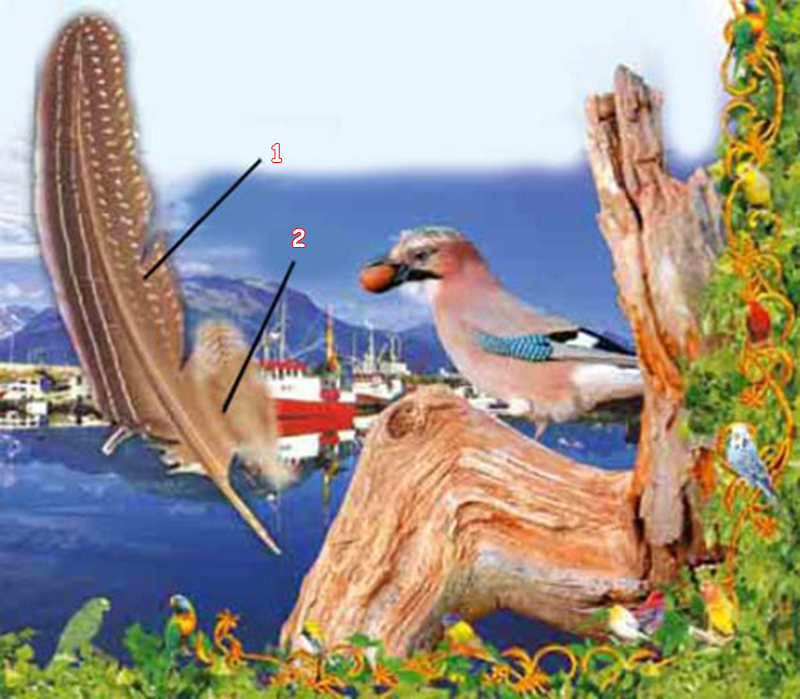 |
| 1. Pennaceous feather |
The feathers of flightless birds—chickens, for example—are very different from those of flying birds. The feathers of flightless birds are tasseled, rather than displaying the aerodynamic structure of those of flying birds. Their tassels are similar to the hairs covering the bodies of mammals—which are arranged so as to provide excellent insulation. 85 Therefore, feathers with a tasseled structure, that do not make flight possible, pose an advantage in terms of insulation.
This deals a severe blow to the evolutionist scenario assuming a progression from thermal insulation to flight. According to that scenario, feathers that evolved for thermal insulation at the outset must have a tasseled structure. Therefore, natural selection will favor only feathers providing improved insulation—in other words, more tasseled feathers. This discourages progress from a tasseled structure to an aerodynamic one.
No fossil records show that the insulating feathers' structure began specializing in the direction of flight. Hair-like feathers in flightless birds actually require this development process to work in the exact opposite direction. In conclusion, not only is the hypothesis that bird feathers evolved from reptile scales self-contradictory, but there is no evidence in the fossil record to support it.
Colors in Bird Feathers are Examples of Allah's Artistry |
 |
| The black, brown and grey pigments in bird feathers are present in the blood, while the red and yellow pigments exist in oil. Lypochrome pigments produce red, orange and yellow shades, and melanin produces black, brown, reddish-brown and grey colors.1 The color spectrum in birds, the bright iridescent blues in their neck and tail feathers, stem from lipochrome and melanin and the different ways they reflect light. Moreover, protrusions on the feather, which can only be seen under a microscope, function as a kind of prism, distributing the light that falls on them in all the colors of the spectrum. This and many other systems are used to create the bright colors on birds. |
Detailed Creation in the Feather's Structure Shows Artistry of Allah
In analyzing the complex structure of bird feathers, Nic Bishop says this in his book The Secrets of Animal Flight:
Feathers may look simple, but they're really very complicated. Each one can have more than a million tiny parts.1
Feathers' complex anatomy varies according to their function. For example, flight feathers' complex shapes result from small wings, resembling fabric, that extend towards both sides. This stem is strong yet hollow, and the extensions on it—known as hooks—have a strong but flexible structure.2
The barbules on the feather have to be strong, yet flexible enough not to snap in the wind. Thanks to this special creation, birds can make better use of air currents than the best gliders ever designed by engineers. Were it not for the tiny hooks in their feathers, birds would be unable to fly at all. These hooks prevent wind damage to the feathers by separating from one another under certain circumstances. However, they can easily combine again when the bird grooms itself with its beak.
Roger Tory Peterson, an expert author on ornithology, says this:
The feather is a marvel of natural engineering. It is at once extremely light and structurally strong, much more versatile than stretched skin on which a bat supports itself in flight, or the rigid structure of an aircraft's wings—and far more readily repaired or replaced when damaged . . . Though nearly weightless, it has strength. The stiff shaft of the quill provides rigidity when support is needed, yet it is supple towards its tip, when flexibility is required for split-second aerial maneuvering. Feel the sleekness of the web, soft yet firm. Separate the barbs; zipper them together again by running them through the fingertips as a bird would preen with its bill. The intricacy of the design that allows this can be appreciated by putting the feather under microscope.3
The Details of Feathers |
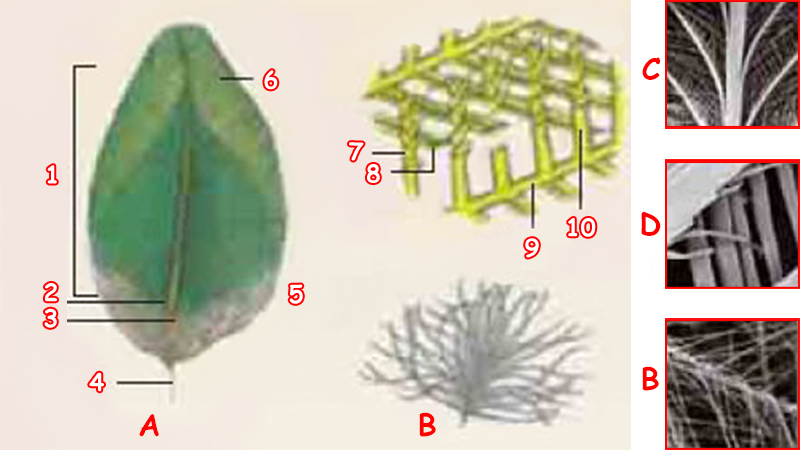 |
| A. Pennaceous feathers |
Feathers have been specially created to permit the bird to fly by causing the air on their upper surface to flow faster than on the lower. Air pressure on the wing is thus reduced, via what is known as the Bernoulli effect. The top surfaces of a plane's wings are, similarly, more angled than the undersides. In this way, air flows more quickly over the top surface, reducing the air pressure there. Since the pressure on the underside of the wing is greater than on the upper, a force that will lift the plane is created and the plane takes off. In birds, the flight feathers are asymmetrical in order to achieve this same effect. In addition, smaller feathers in the wing's front edge are in direct contact with the air.
The complex aerodynamic principles in the avian wing also include a mechanism that reduces the negative effects of air pockets and downdrafts, the main cause of plane crashes.4 The specially created fissures at the edge of the bird's wing transmit part of the air. This is a feature that engineers seek to imitate in modern planes by designing additional small wing edges on the wings.
Moreover, birds are able to change the shape of their wings in such a way as to facilitate air flow during takeoff, flight control and landing. They can also fold their feathers to alter their air resistance, by the use of an exceedingly complex tendon system.5
Bird feathers, the underlying skin and subcutaneous muscles, the tendons that connect the bones and organs, the brain, and sense organs are interdependent. This system, essential for flight, is irreducibly complex. The absence of any one component will prevent flight. The fact that details such as the angle and thickness of the feathers' parts exhibit so little variation is vitally important,6 because minor variations will impair the system in general.
Special muscles in the skin let the bird move its feathers in a detailed, controlled manner. This system helps the bird fly and also protects it. Birds puff up their feathers to discourage their enemies by appearing larger, to keep themselves warmer, or to attract the interest of other birds during the mating season.7
Another condition for flight is that the feathers in the wing and tail must be laid out exactly as required—which presents another problem for evolutionists. Feathers, whose origins evolutionists are unable to account for in any case, must also be arranged in an appropriate manner to make flight possible at all. The angle that feathers need to lie in, their size and location, and their need to be arranged symmetrically in both wings cannot be explained in terms of unconscious, random genetic changes.
The Details of Feathers |
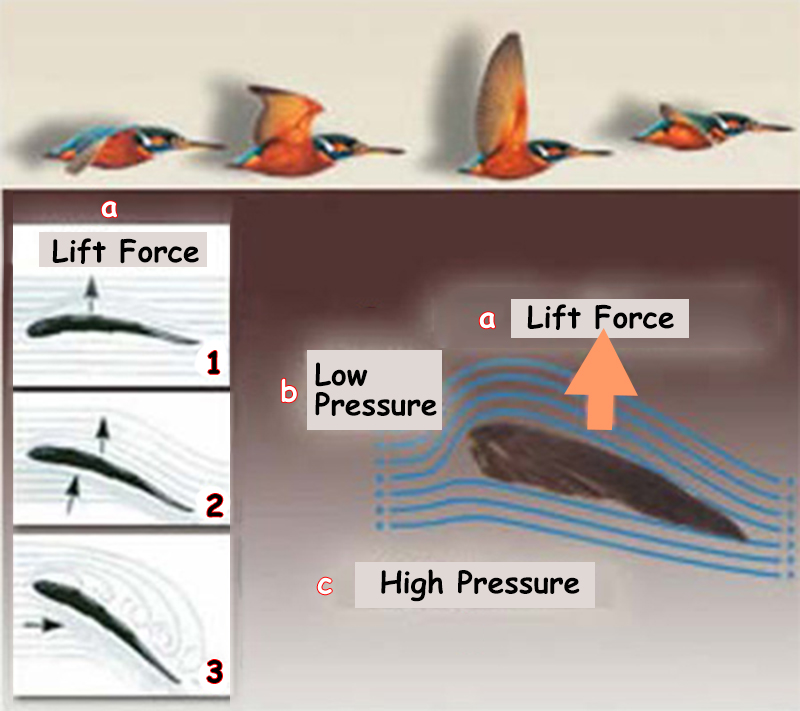 |
| a. Lift Force |
The information regarding all feathers' physical structures lies hidden in DNA, as does the number of keratin layers and their thickness, the number of barbules, colors, the distance between feathers, and all of other details. As we know, the slightest error in the sequencing in a living thing's genetic data—its DNA—causes serious morphological and functional defects. To believe that such sequencing errors, or mutations, originally gave rise to feathers is to believe in the impossible. The encoded information for the growth of a feather is very different from that for a scale. Scales developing into feathers, as evolutionists claimed, requires the emergence of brand-new data in the specie's DNA.
Every detail in the feather structure, such as its shape and color—the hook and corresponding barb being of the right thickness, for example—must be determined by new instructions added to the genetic code. However, the effects of natural selection and mutation, which the theory of evolution maintains are unconscious and random, cannot explain how the genetic information for such a perfect structure arose in a bird's DNA.
In addition to the feather's complex structure, it is also impossible for its beauty and symmetrical, regular patterns to have emerged via random mutations, as evolutionists would have us believe. Countless laboratory experiments have definitively demonstrated that mutations cannot add information to an organism's DNA. Mutations always lead to defects in a creature's systems or morphology (form). To believe that complex structures and stunning beauty like the peacock's came into existence through random mutations is as illogical as believing that a wooden shack could transform into a palace under the effects of rain, lightning, and wind.
Footnotes 3
1. N. Bishop, The Secrets of Animal Flight, Boston: Houghton Mifflin, 997, p. 9.. 
2. W. J. Bock, "Explanatory History of the Origin of Feathers," American Zoologist, Vol. 40, 2000, pp. 478-485..
3. R.T. Peterson, "The Birds," Time, New York, 1963, p. 33. 
4. M. Denton, Evolution: A Theory in Crisis, Adler and Adler, Bethesda, 1986, s. 202. 
6. S. F. Tarsitano, A. P. Russell, F. Horne, C. Plummer, K. Millerchip, "On the evolution of feathers from an aerodynamic and constructional point of viewpoint", American Zoology, vol. 40, 2000, ss. 676-686. 
7. S. Burgess, "The Beauty of the Peacock Tail and the Problem with the Theory of Sexual Selection", The in Depth Journal of Creation, vol. 15, no. 2, 2001, ss. 94-102. 
Evolutionist Errors Regarding Bird Feathers
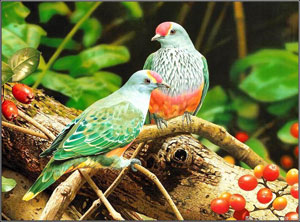 |
| And in your creation and all the creatures He has spread about there are signs for people with certainty. (Surat al-Jathiyya, 4) |
Some evolutionist publications equate the fact that in peacocks and certain other bird species, the males are more brightly colored and showier than the females with the sexual selection thesis set out by Darwin in his book The Descent of Man, and Selection in Relation to Sex, published in 1871
In sexual selection, the stronger, more impressive animals in a population are more attractive to the opposite sex and thus have more offspring. According to this distorted logic, the showy patterns and designs in some male birds are features acquired over time, as a result of females "naturally selecting" more physically impressive males. However, no scientific findings square with Darwin's thesis. Such interpretations are nothing more than an evaluation of the attributes of living things through an evolutionist preconception.
One evolutionist scientist who opposed to such interpretations set his views out in Nature magazine:
There are several other possible reasons for sexual differences which this study did not address, says Trevor Price of the University of California at San Diego, who also works on differences between bird species. For example, he says certain territorial species that fight a lot show large sexual differences, perhaps because bigger, brighter males intimidate invaders and win more fights—and more mates. Nonetheless, these male populations maintain diversity, Price says, as duller males can sneak in some copulations while flashy males are busy fighting.1
To maintain that bird feathers were shaped by evolutionary mechanisms, adherents must describe mutations that could lead to the form changes in feathers, but without harming the host creature. In fact, however, there is no evidence that such mutations are possible. Furthermore, the frequency of such mutations in nature must be estimated and in the light of this genetics data, a calculation made as to whether such an evolutionary process is actually possible. One similar calculation was performed by the Israeli biophysicist Lee Spetner, who concluded that, according to population genetics data, it is impossible in practical terms for one species to evolve into another2
But evolutionists deal not with realistic calculations like this, but with imaginary scenarios. Due to their blind belief in the existence of evolution, they make do with asking, "Which scenario?" and seek to answer that question with the help of their imaginations. They interpret the fact that bird feathers have colors by saying "Brighter colors are encouraged through natural selection." They explain the fact that some birds have drabber colors by saying that they are drab because natural selection made drabness an advantage in avoiding the notice of predators. One can come up with explanations for anything in terms of natural selection, yet these will be solely imaginary. Therefore, the theory of evolution is not scientific, but a dogmatic mode of interpretation. Anyone who does not condition himself with Darwinist preconceptions and approaches the issue with reason and logic will easily realize that the extraordinary signs of creation in living things cannot be the products of unconscious natural mechanisms, but reveal the infinite might and artistry of Almighty Allah.
Footnotes 4
1. "Sex Drives Birds Apart: Promiscuity Makes Females Dull And Males Flashy", Nature Science Update, 13 March 2001; http://www.nature.com/nsu/010315/010315-5.html 
2. Lee Spetner, Not By Chance, The Judaica Press, New York, 1997. 
The Intention in Birds' Anatomy Amazes Scientists
 |
| Prof. Andy McIntosh |
During an interview in Australia, Professor Andy McIntosh, a member of the University of Leeds teaching staff and an expert in the field of aerodynamics, made the following comments about the perfect structure in birds:
- Prof. Andy McIntosh: Many aspects of nature show that creatures have been designed. . . creatures which fly. I got here to Australia on a great big jumbo jet. I watched the careful maneuvering as it came down to land, as the great big flaps came out at the back, increasing the size of the wing to get more lift so as to fly at a much slower speed. I was struck by all the design that went into that wing in order to make sure it worked. Now, are we to say that the birds which come to land every day weren't designed? I have seen a photo in a book, of an aircraft landing at Hong Kong, and underneath it is a falcon landing at the same time. Now as you look at birds and planes together, are you going to say that one is designed and the other isn't? I would find that scientifically preposterous.
◉ Chris Field: We know that in order for modern flight to take place, countless thousands of man-hours and much high technology had to go into the design process.
◉ Prof. Andy McIntosh: Indeed—I would take issue with people like [atheistic Oxford professor] Richard Dawkins, with his view that flight somehow came about by chance, just because some creature took a jump, then mutation added bits to its structure, so it could jump further, and so on. It just doesn't fit. It's obvious that these creatures have not come about by chance and selection, but have in fact been designed.
◉ Chris Field: Why the particular interest in flight?
◉ Prof. Andy McIntosh: Well, I am originally an aerodynamicist—my Ph.D. was in an aerodynamics department. Bird flight in particular is remarkable. Consider feathers. If you look at a feather under a microscope, you see the main stem, with barbs coming out to the left and right, and from these you have left-and right-handed barbules. Now, the interesting bit is that the left-handed ones have hooks, and the right-handed ones have ridges.
◉ Chris Field: That's so the feathers lock together.
◉ Prof. Andy McIntosh:That's right. The feather is made such that if you bend it, everything bends with it, and yet it's a very light structure. So the hooks catch the ridges and they slide over the ridges—it's a mechanical engineer's dream to have such useful, lightweight engineering. But if you have a sliding joint, you need lubrication. To do this the bird twists its neck around 180° and dips its beak into a tiny oil gland right down at the back of its spine. It then preens itself, wiping this oil all over its feathers, so that they join together nicely, and these sliding joints are oiled. That's a marvellous bit of engineering. So is the fact that birds, unlike us, have hollow bones. To be strong enough, particularly in the bigger birds, these lightweight bones often have cross-members. In aircraft we call the design 'Warren's truss,' but we copied it from birds in the first place. . . Design is shouting at me everywhere.1
As you have seen, those whose mental horizons are not restricted by belief in evolution can easily discern the signs of superior creation in living things. They see the illogicality of seeking to account for these in terms of chance, and can appreciate Allah's creation in living things.
People with such awareness are described in these terms in the Qur'an:
The kingdom of the heavens and Earth belongs to Allah. Allah has power over all things. In the creation of the heavens and the Earth, and the alternation of night and day, there are Signs for people with intelligence: those who remember Allah, standing, sitting and lying on their sides, and reflect on the creation of the heavens and the Earth: "Our Lord, You have not created this for nothing. Glory be to You! So safeguard us from the punishment of the Fire."(Surah Al 'Imran, 189-191)
Do they not see the birds suspended in midair up in the sky? Nothing holds them there except Allah. There are certainly signs in that for people who believe.(Surat an-Nahl, 79)
The Irreducible Complexity in Wings
 |
One obvious distinguishing feature between birds and reptiles is that birds have wings. As you saw in the preceding chapter, the feathers comprising the wing constitute a field of research all of their own, and their complex creation amazes scientists. However, for a bird to be able to fly, it is not enough for it to have feathers. Those feathers need to be distributed in a specific sequence equally on both wings. If you set out a bird's feathers at random—and the feathers are denser on one side, for example—then an imbalance will arise, and the bird will be unable to fly. In addition, the facts that wings can be opened and closed, that both are symmetrical, that their structure permits flight techniques, all show that they have been specially created for flight.
Although scientists use birds as models to imitate, they can never manage to produce wings as successful as birds'. Considering that humans, possessed of reason and technology, cannot imitate the wing that birds possess from the moment they are hatched, you can better see how these animals' ability to fly is a miracle of Allah.
How did such complex structures as the eye, lung, wings and the cell develop in stages? This question is one of the greatest dilemmas facing evolutionists. These structures consist of interrelated components, none of which serve any purpose in the absence of any other. They cannot have formed gradually, as evolutionists claim, because the absence of any one component will make the organ functionless. Scientific literature refer to this as irreducible complexity. Since a half-developed wing will be of no benefit to an organism, then according to evolution's own claims, that useless organ will become vestigial and gradually disappear.
This presents an insoluble problem for the theory of evolution. The atheist evolutionist Richard Dawkins effectively admits as much:
Evolution is very possibly not, in actual fact, always gradual. But it must be gradual when it is being used to explain the coming into existence of complicated, apparently designed objects, like eyes. For if it is not gradual in these cases, it ceases to have any explanatory power at all. Without gradualness in these cases, we are back to miracle, which is simply a synonym for the total absence of explanation. 86
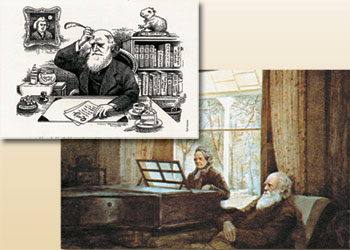 |
| The last century has seen developments that all argued against Darwinism. Advances in technology and scientific understanding confirmed Darwin's own doubts about his theory and revealed that the theory of evolution had no scientific basis. Darwin proposed his theory of evolution, the product of an outdated scientific conception, for the sake of denying the evident creation in living things. This theory, the gravest misconception of the 19th century, was merely the work of an amateur biologist. |
Evolutionists offer inconsistent explanations to the effect that wings developed from reptiles' forelegs. In essence this scenario runs: "Some reptiles grew a few hairs on their forearms and used these to catch insects. However, most insects escaped before they could carry them to their mouths (!) The system did not work well in this unbalanced state. They could not fly, nor climb trees, nor escape into any hole in the ground. Under these conditions they needed to undergo a change in order to flee their enemies. Just at that point coincidences performed the necessary alterations in these creatures and turned them into living things capable of flight."
This and similar scenarios, no more logical than fairy tales, cannot explain how these changes combined in a specific sequence and in such a way as to respond to the creature's need to catch insects. In his book Darwin's Dangerous Idea, Daniel C. Dennet condemns Darwin's claims that unconscious mechanisms could give rise to the perfect living things in nature:
Here, then, is Darwin's dangerous idea: the algorithmic level is the level that best accounts for the speed of the antelope, the wing of the eagle, the shape of the orchid, the diversity of species, and all the other occasions for wonder in the world of nature. It is hard to believe that something as mindless and mechanical as an algorithm could produce such wonderful things. No matter how impressive the products of an algorithm, the underlying process always consists of nothing but a set of individually mindless steps succeeding each other without the help of any intelligent supervision; they are automatic by definition: the workings of an automaton. They feed on each other, or on blind chance—coin-flips, if you like—and on nothing else. . . . Can it really be the outcome of nothing but a cascade of algorithmic processes feeding on chance? And if so, who designed that cascade? Nobody. It is itself the product of a blind, algorithmic process. 87
Dennet then cites Darwin's words regarding what would invalidate his natural selection theory: As Darwin himself put it, in a letter to the geologist Charles Lyell shortly after publication of Origin, "I would give absolutely nothing for the theory of Natural Selection, if it requires miraculous additions at any one stage of descent . . . if I were convinced that I required such additions to the theory of natural selection, I would reject it as rubbish." 88
In the above words, Darwin admitted that to account for the origin of living things, the need for "miraculous additions" would invalidate his theory. At that time, science was not sufficiently advanced to disprove Darwin's claims. However, scientific understanding attained in the 20th century showed that living things could not be explained in terms of coincidence. It was concluded that the flawless structures in living things—a bird's wing, for instance—had to have arisen without any transitional stages.
 |
This is just one example showing that Darwin's worries were justified.
For a bird to be able to fly, its wings must be strongly attached to the bird's breast protrusion. The wings must also have a structure able to lift the bird into the air, maintain balance and change direction. It is also essential that the feathers be light, flexible and in proportion to one another functioning in a perfect aerodynamic order that permits flight. But here evolutionists find themselves in a grave predicament: They cannot explain how a reptile's forearms could have turned into flawless wings through defects (mutations) arising in its DNA. To assume that flight evolved means that at certain stages, the wing was insufficient—and thus, impractical. Yet flying with insufficient wings is out of the question. In order for an animal to fly, its wings and the anatomy supporting those wings must be perfectly and fully formed.
Engin Korur, a Turkish evolutionist biologist, admits as much:
The common feature of eyes and wings is that they can fulfill their functions only if they are fully developed. To put it another way, one cannot see with a deficient eye, nor fly with half a wing. How these organs formed is one of the still unsolved mysteries of nature. 89
As the above extract makes clear, even if we assume that some mutation did bring about a change in a reptile's forearms, it is still irrational to expect that new mutations might be added to this and that a wing could emerge by chance. Any mutation in the forearms will not endow the creature with functioning wings, but will deprive it of functioning forearms. This will leave the deformed creature disadvantaged in comparison with other members of its species. According to the theory of evolution, natural selection will then eliminate that handicapped individual.
Birds, the fastest living things on Earth with the features bestowed on them by Allah… |
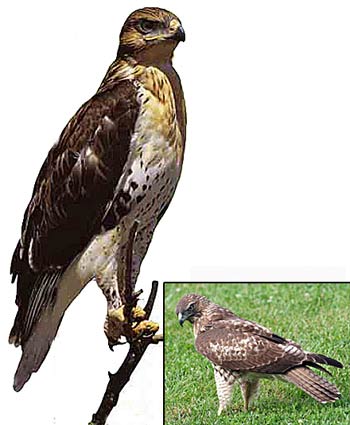 |
| The avian wing possesses its own unique form, ideally suited to flight. The hawk, has perfect flight control. Flying at a speed of 300 kilometers an hour (186.4 miles per hour) as it swoops down on its prey, it never loses its balance or misses its target. The African eagle can suddenly accelerate to 185 kilometers an hour (114.95 miles per hour) to attack its prey, and can then hover in the air at a distance of 6 meters (19.685 feet) by opening out its wings. These birds are quite adept not only in terms of their flight and speed, but also of their sharp eyesight. A predatory bird can circle its prey from kilometers high and follow it with its sharp eyes. In descending to attack, it automatically adjusts its eyes without losing its focal point or blinking. |
The Harvard University paleontologist James Gould wonders whether such deficient structures could be of any use:
Gradualists usually extract themselves from this dilemma by invoking the extreme imperfection of the fossil record—if only one step in a thousand survives as a fossil, geology will not record continuous change. Although I reject this argument . . . let us grant the traditional escape and ask a different question. Even though we have no direct evidence for smooth transitions, can we invent a reasonable sequence of intermediate forms—that is, viable, functioning organisms—between ancestors and descendants in major structural transitions? Of what possible use are the imperfect incipient stages of useful structures? What good is half a jaw or half a wing? The concept of preadaptation provides the conventional answer by permitting us to argue that incipient stages performed different functions . . . But a plausible story is not necessarily true. . . . but does it [gradualism] permit us to invent a tale of continuity in most or all cases? I submit, although it may only reflect my lack of imagination, that the answer is no. . . . 90
Biophysical research has shown that mutations occur only rarely. Therefore, it is impossible for these imaginary reptiles who possessed incompletely developed wings, to wait millions of years for mutations to complete them. In addition, mutations always have harmful results. All these scientific facts invalidate the scenarios of dinosaur-bird evolution.
One of the most frequent evolutionist claims is that needs endow living things with useful organs. We are told that some animals gradually developed oral cavities out of a need to feed, that others developed feet by seeking prey on land, that some acquired wings because flight would be advantageous, and many other such tales. In short, Darwinists use the mechanisms of natural selection and mutation to account for every feature we see in animals.. However, all these unscientific claims are totally unable to explain the origin of complex structures in living things.
It would be irrational to expect unconscious cells, which allegedly came into being by chance, to agree among themselves and come up with a plan to give rise to a wing that will enable the body to fly—and then to work until they achieved the appropriate scale and structure. In such a case, the cells comprising the wings would need to be aware of the functions of other organs and cooperate with them. Having achieved the most appropriate structure, they would also have to take a collective decision to stop evolving.
To suggest that any complex structure appeared as the work of chance would be irrational and illogical. Yet rather than accept the truth of creation, evolutionists prefer to lend credence to such an irrational possibility, and even to refer to it as not worth debating.
However, countless questions are raised by these coincidental evolutionary scenarios. For example, how is it possible for chance, unaware of the existence of an ability such as flight, to identify a need for it and to design the wing in a flawless manner? How can the cells consider all the relevant details such as structure, size and shape, enter into a division of labor with other cells and build such a complex organ as the wing?
It is of course impossible for chance to do any such thing.
Even a single bird is sufficient evidence to disprove the claims of evolution. The fact that evolutionists insist on denying that truth shows that they defend their theory in the face of all the facts.
Scientists' Dream:Plane Wings as Mobile as Those of Birds
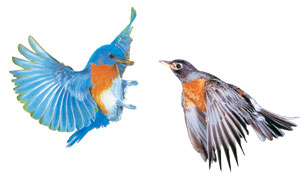 |
| A bird's wing possesses the ideal structure, shape, and properties for flight. For example, birds use their feathers to keep themselves aloft and balanced. John H. Storer has stated in Scientific American magazine that every bird has a dual remote control, which can best be observed in slow-motion photography. |
The Morphing Project, managed by Anna-Maria McGowan and carried out at the NASA Langley Research Center, aims at producing a plane able to move its wings according to varying weather conditions—just like a bird. Presently, the wings of subsonic planes (those traveling at less than the speed of sound) are manufactured according to a specific height, speed and load. When flight conditions change, however, the shape of the wing must also change. In McGowan's words, "The kind of wing you need at very low speed and the kind of wing you need at high speeds are completely different."1 Otherwise, problems will arise such as excessive fuel consumption, unwanted turbulence and excessive noise.
Under present-day circumstances, however, such wing changes are impossible because wings are made from very hard materials. For that reason, NASA is working on an "intelligent wing" project, run with the participation of DARPA (Defense Advanced Research Project Agency) and the AFRL (Air Force Research Laboratory). The objective is plane wings that are connected to a central electronic system, as living things are by their nervous system.
Bill Uher of the NASA Langley Research Center says this about the project:
The receptors will be nerves just like those in the bird wing and will constantly measure surface pressure. Activators will either expand or contract the aircraft's wings. Thus they will change the shape of wings, just like muscles.2
In the wing model currently being worked on, the mechanical energy of the forces applied is turned into electrical energy, and the energy created that emerges by means of structures resembling joints, gives rise to a movement resembling flapping. Tests show that the wing can bend up to 20 degrees. It's expected that the Morphing Project will make still more progress in designing new wing structures inspired by the flying techniques of birds.
The objective is the design of wings that can fold themselves, like those of birds, without the need for moving parts. Friction will thus be reduced, and fuel saving increased. Birds are again the chief model to make this dream a reality: wings that can stretch and change shape according to prevailing air conditions, and which can adjust themselves as they fold up.
Some present-day planes—namely, the military's F-14, Tomcat and B-1 Supersonic bomber—are able to adjust their wings. However, these planes use wide, rigid wings mounted onto heavy struts located in the aircrafts' fuselage. Scientists working on the Morphing Project are designing wings that can open on command, by using metal compounds and materials they describe as having "shape memory" or "intelligence." The theory is that when a specific level of heat is applied, these wings will immediately revert to their original shapes with great force.
The materials used in these wings' manufacture—piezoelectric materials (which create electrical energy from pressure)—link electrical voltage to movement. If you bend a piezoelectric material, it produces voltage. Conversely, if you apply voltage, the material will bend.
Anna-Maria R. McGowan, director of the Morphing Project, says about the technology in question:
When we look 20 years into the future, we see airplanes that have distributed self-assessment and repair in real time. . . . To make this technology possible, you would need to distribute these actuators and sensors throughout the wings. That's similar to how the human body operates. We have muscles and nerves all over our bodies—so we are aware of what's happening to our bodies and we can respond to it in a number of ways.3
 |
One method employed in the Morphing Project's research is the analysis of systems that already exist in nature. From these models, scientists hope to learn techniques that they can use to develop their own designs. As McGowan says,
Birds are so much more maneuverable than our airplanes are today. Birds can hover, they can fly backwards and sideways. And insects—upside down, loop-de-loop, all sorts of things. We can't even get close to that. 4
Achievements in this technique of learning from nature, known as biomimetics, have led scientists to imitate the structure of avian bones for airplane wings. Birds' bones are light, strong and porous, with a hollow structure that admits air. McGowan states that they hope to achieve a similar structure:
If you can have the strength and light weightiness of these bone-like structures that I'm talking about, then add in nerve-like sensors and these flexible actuators, what you're going to end up with is an extremely light-weight, very strong, self-sensing, self-actuating structure.5
All these are ideals that scientists have set out through being inspired by birds' wings. If a bird can act as a source of inspiration for a scientist, if it can serve as a guide for a project, then clearly there is something quite extraordinary in its structure. It is impossible for such a perfect structure to be the product of unconscious coincidences and random processes. The intelligence that scientists seek to imitate and which so amazes them is just one of the countless examples of the infinite intelligence, knowledge and creative artistry of Allah.
Is He Who creates like him who does not cerate? So will you not pay heed? If you tried to number Allah's blessing, you could never count them. Allah is Ever-Forgiving, Most Merciful. Allah knows what you keep secret and what you make public. Those you call on besides Allah do not create anything. They are themselves created. (Surat an-Nahl, 17-20)
Footnotes 6
1. Patrick Barry, "Bionic Research Points To Smart Flexible Aerospace Materials," Space Daily, 5 March 2001; http://www.spacedaily.com/news/materials-01f.html 
2. "When The Planes Flap", Science et Avenir, January 2003, p. 74. 
3. Patrick Barry, op. cit, http://www.spacedaily.com/news/materials-01f.html 
The Perfect Flight Technology in Living Things
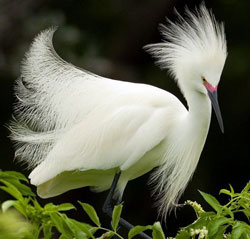 |
| When you consider how many elements and delicate calculations come into play to keep an airplane flying, you can see how difficult the action performed by birds, truly is. |
In many ways, it is impossible to account for birds' ideal structure for flight in terms of evolution. The structure of the wing as described in the last chapter is just one of these impossibilities. Flight is based on a very complex system, and to control it, the bird must have a nervous system capable of controlling its muscles flawlessly. In this nerve-muscle control, after the muscles contract with commands they receive from the nerve cells, they transmit back signals that report their position. When a bird rises, glides in the air or descends to earth, this feedback system goes into action to create the required aerodynamics.
When we examine how animals adapt to their environments, we realize that the mechanisms' in many creatures' bodies go far beyond the technological achievements that we humans are so proud of. Flight is one of the most striking examples. If a small airplane were as efficient as a plover, it could fly for 56 kilometers (34.796 miles) on a single liter of petrol. At present, however, such economical flight is no more than a designers' and engineers' dream.
Birds' perfect aerodynamic structure, which amazes scientists, can be seen in every detail of their bodies:
◉Feathers which, in proportion to their weight have a very strong but also flexible and light structure,
◉ Powerful wings controlled by powerful muscles,
◉ Flexible, strong but also light and hollow bones,
◉ A unified skeletal structure,
◉ A large, powerful heart and a circulatory system with high levels of blood pressure and the pigment myoglobin, which facilitates respiration,
◉ A respiratory system with air sacs extending as far as the bones,
◉ A digestive system that ensures high body temperature and sugar accumulation,
◉ The collection of waste fluids in the body for the purpose of preventing water and weight loss,
◉ A navigation system, the secrets of which have still not been understood,
◉ Powerful nerve co-ordination that regulates the position of every feather during flight...
None of these properties, of which more could be listed, is sufficient for flight on its own. Yet birds are able to fly when all features are present together. It is impossible for each one to have developed gradually, independently of all the others, and then to adapt to one another. All these features make bird flight possible, but none can do so independently, on its own.
Birds Anatomy, Ideally Suited to Flight Are Proofs of Creation … |
 |
| 1. Birds' special respiratory system constantly meets their high oxygen requirements. |
The researcher and writer Richard Milton is a documentary producer for BBC and NBC and a member of the Geology Society, has this to say about the aerodynamic structure in bird flight:
...I believe that this example represents a belief shared by many, Darwinist or not: There is inevitability in the design of human beings and other species. There is a delicacy and beauty in bird flight [that] other less efficient flight designs lack, and this enables birds not just to conquer the skies, but also to rule them. In addition, this perfect form can clearly be seen in artificial, human designs such as automobiles and jet planes: many experimental designs over tens of years have reached an optimum design by being passed through the filter of experience . . . the flight of the eagle and the fast running of the cheetah … these animals have not reached a random point in the genetic sphere; they enjoy an unrivalled position enabling them to make the best use of their surroundings. 91
For years, birds' matchless modes of flight and wing structure have been a source of inspiration for aeronautical engineers. Yet obviously birds could not produce all these components on their own. It's equally irrational to imagine that a so-called evolutionary process, working at random, could have produced all these perfections. Their structures were evidently created so that birds could fly. This creation is that of our Almighty Lord, and "There is no creature He does not hold by the foreloc"(Surah Hud, 56)
In another verse of the Qur'an, our Lord Allah reveals:
Have they not looked at the birds above them, with wings outspread and folded back? Nothing holds them up but the All-Merciful. He sees all things. (Surat al-Mulk, 19)
Birds Carry Out Their Aerodynamic Flight through the Inspiration of Allah
The science of aerodynamics studies the movement of solid bodies through fluid ones such as air. For example, when a plane moves through the atmosphere, it produces various forces that affect its movement. In the face of these aerodynamic forces, engineers produce designs that will enable planes to move through the air more easily.
In order for any object, planes included, to move through the air without encountering any unexpected force or resistance, it is first tested against air resistance in a so-called wind tunnel. This is done either by passing a current of air over a fixed, stationary model of the plane in a laboratory environment. The movement of the body and the surrounding air is then adjusted according to resulting calculations, measurements and further experiments.
Scientists Contiune to Draw Inspiration From the Perfection in Living Things
Inspired by the way that geese fly, scientists are developing a system that will enable planes to fly autonomously for long distances in a V formation. They hope that this flight pattern will lead to energy savings for planes, as it does for geese during their long migrations.
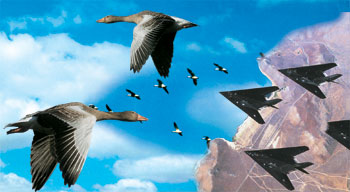 |
Jet planes following in a V formation save energy by following in the slipstream set up by the leading plane. Keeping the lead plane at the ideal location manually is a tiring business, and so engineers at NASA's Dryden Flight Research Center, UCLA and Boeing facilities are developing a system to do this automatically. One day, scientists hope, passenger, freight and military planes will be able to make energy savings of 20% by imitating geese's flight pattern.
Brent Cobleigh, chief engineer on the project, says, "A 777 airplane flying 250 days a year, going from New York to L.A. and back once a day, would save a half a million to a million dollars in fuel."1 Indeed, two NASA jets first showed that this flight pattern could provide major fuel economies. Despite flying the same distance, the second plane used 12% less fuel than the leader.
He (Musa)said ''The Lord of the heavens and the Earth and everything berween them if you knew for sure (surat ash-shu'ara 24)
1. Fenella Saunders, "It's a Bird, It's a Plane", Discover, vol. 23, no. 5, Mayıs 2002.
Models of planes, rockets, cars, and even bridges and buildings are first tested in such wind tunnels, in which they are exposed to air currents adjusted to the speed of the experiment. By observing the behavior of these models in the streamline flow, necessary adjustments are made to give the model a more aerodynamic shape.
The Wise Creation in Birds Metabolisms
Hummingbirds possess the fastest metabolic rate of any vertebrate. Their hearts, which beat 700 to 850 times a minute when the birds are at rest, begin beating 1,200 times a minute when they hover in the air. In relation to their size, they expend more energy than a jet plane. If you consumed energy at that same level, your body temperature would rise to 400 degrees Celsius—and in order to meet that energy requirement, you would have to eat 45 kilograms of sugar every day.
 |
Yet when at rest, these birds reduce their body temperatures from 40 to 15 degrees Celsius and efficiently slow their metabolisms at the same time. They adopt a particular posture in order to save energy, during which they puff up their feathers, raise their beaks up in the air and reduce their heart beat to 50 beats a minute.1
llah has created these tiny creatures with a great many superior features. For anyone able to appreciate Allah properly, these birds are one of the countless proofs of His powers. In one verse it is revealed:
And in your creation and all the creatures He has spread about there are signs for people with certainty. (Surat al-Jathiyya, 4)
1. John Downer, Supernature, The Unseen Powers of Animals, Sterling Publishing Co., Inc., New York, 1999, ss. 161-162.
Aerodynamics comprises a wide range of disciplines, from aviation and space research to the automobile industry and civil engineering. For example, in order for a new car to be economical and expend less fuel, a model of it is first tested in a wind tunnel, and engineers try to find the aerodynamic shape with the least resistance. Birds' unique and flawless properties, which exhibit the principles of aerodynamics, amaze scientists. They fly perfectly, with no trial and error and with no need for any subsequent adjustments.
As birds glide, they remain aloft in the same way as planes. In addition, while birds flap their wings to descend or climb, planes must use powerful engines and control systems to achieve the same results. A plane's wing is tilted in the same way as a bird's. Unlike human engineers, however, birds carry out no tests, and are born possessing an aerodynamic structure and powerful wing muscles to provide them with the needed energy during flight.
 |
| Planes undergo thorough maintenance before and after every flight. Dozens of mechanics join forces to do this. Bearing in mind that the slightest oversight could cause a plane to fall out the sky, it is clear how many details need to be considered. Birds, on the other hand, carry out this maintenance themselves. Using their beaks, they oil their feathers from oil glands at the base of their tails. This intelligent behavior is inspired by Allah. |
Modern analysis of bird flight is made possible by extraordinary technological advances and the discoveries in the fields of flight mechanics and aerodynamics. Birds possess none of this knowledge, however; they can neither analyze nor calculate, nor perform test flights. Yet they still maneuver to perfection, glide, accelerate, descend and stop suddenly because Allah has created them with a perfect flight system—the most superior technology—from His own knowledge.
Do they not see the birds suspended in midair up in the sky? Nothing holds them there except Allah. There are certainly signs in that for people who believe.(Surat an-Nahl, 79)
The Aerodynamic Technology in Birds Continues to Inspire Engineers
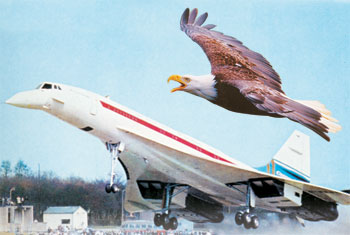 |
| The noses of planes are designed using the special aerodynamic structure of birds as a model. Scientists adapting the perfect solutions found throughout nature are thus able to achieve their goals more quickly, with less time and energy. |
The perfect flight systems in birds are an inspiration for engineers. Seeking to produce the most efficient designs with the most appropriate materials and at the lowest cost, engineers have long been imitating this superior creation in nature. For example,
◉ Plane wings are hollow, like bird bones. Inside of bird bones, there are fine struts between the opposite surfaces to reinforce them. The same kind of struts are used in aviation engineering, serving as a skeleton that holds the wing together despite strong and variable air currents. Known as Warren's trusses, these have been copied from bird bones. 93
◉ The ailerons used to control a plane's altitude and which angle down from the wing have been arranged to imitate the movement of the wings as a bird lands.
◉ In the same way as birds' heads, airplanes have a nose intended to overcome air resistance.
Modern-day planes' ability to make sudden maneuvers is much lower than birds'. In order to manufacture planes with higher maneuverability, we need a better understanding of the birds' aerodynamic systems. William Zamer of the American National Science Committee says this about one study performed on birds.
The results may also one day help humans design better vehicles for both land and air travel. 94
The following statement appeared in a scientific article about birds in Reader's Digest magazine:
Compared to birds, a marvel of aerodynamics, even the most advanced aircraft are nothing more than crude copies. 95
He Who created the seven heavens in layers. You will not find any flaw in the creation of the All-Merciful. Look again-do you see any gaps? Then look again and again. Your sight will return to you dazzled and exhausted!(Surat al-Mulk, 3-4)
Birds Flight Technology: Humanisty Constant Dream For Hundreds of Years
One goal that has literally become a dream for scientists is wing beating. A hawk beats its wings 2.5 times a second at an angle of 120 degrees, and a hummingbird 80 times a second, while machines produced by humans are far from displaying such mobility and flexibility. Engineers have produced aircraft able to fly over mountains and oceans, yet it is still not possible for them to ascend by flapping their wings. The University of Toronto's ornithopter—a machine designed to carry a human passenger into the air by flapping its wings, in imitation of birds, bats or the pterodactyl, a flying reptile that lived in prehistoric times—is one model that most closely approaches this ancient aeronautical dream.
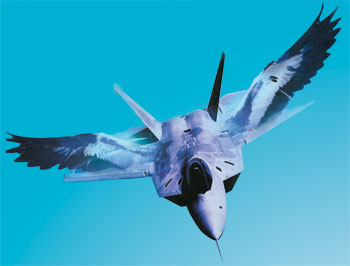 |
Patricia Jones-Bowman, an ornithopter test pilot, says:
The race is on to be the first in history. It's been 500 years since Leonardo da Vinci (designed an ornithopter), and it is time for this to be conquered.1
In order to discover aerodynamic secrets, Jones-Bowman makes use of fossils of the pterosaur, bat-like reptiles whose membranous wing span reached up to 10 meters (32.8 feet). According to the U.S. Defense Department, however, beating wings present a number of aerodynamic problems that make it difficult to replace fixed-wing planes.
Flight was humanity's dream for thousands of years, and is now a discipline in which thousands of scientists and researchers expend labor, time and money. Apart from a few very primitive experiments, flying vehicles became possible only in the 20th century. Birds, on the other hand, under inspiration from Allah, have been flying to perfection on Earth for the 150 million years of their existence..
Before planes, various 19th-century inventors strapped homemade wings to their arms and experimented jumping from high places while flapping their arms. The results, however, were usually fatal.
As you have seen, it is even more difficult to combine both conditions—wing beating and reduction in size. The fact that birds have small bodies and can flap their wings with no difficulty should make people reflect on the perfection in Allah's creation.
 |
People engaged in the field of biomimetics study tuna in order to unravel the secrets of swimming, grasshoppers to unravel those of jumping, and cockroaches and lobsters for rapid navigation in bumpy spaces. Wings interest engineers studying nature with the aim of producing new ideas in the field of machine design. Michael Dickinson, a biology professor of University of California at Berkeley who also assists with government-backed robot flight design, says this:
There is growing collaboration between biologists and engineers. If we look at the architecture nature... maybe we can extract that out and copy it. 2
Hundreds of years ago, this inspired Leonardo da Vinci to sketch the first plans for an ornithopter. However, it would have been exceedingly difficult to turn these drawings into a working model. In studying the flight displays put on by a sparrow or a crow, scientists revealed the principles of the science of aerodynamics.
In contrast to a plane, which moves in the air with the help of an engine, a bird obtains its own lift and propulsion force by using its wings. In order to do so, birds constantly change the angle at which their wings encounter air currents. This way, they immediately adapt to changing conditions and continue flying with no problems. Airplanes are immediately affected by weather conditions, and since flying under such conditions can be dangerous, flights have to be cancelled from time to time.
One group of students led by James DeLaurier of University of Toronto are carrying on the ornithopter goal by using birds as models. Their design will be propelled forward in an ideal flight pattern as its wings rise and fall. Scientists working on this reported on the perfect nature of birds' creation:
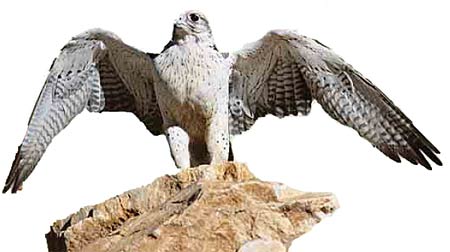 |
Like Jones-Bowman, all those who have worked on flapping flight say the work has given them new respect for the engineering genius of nature. Paul MacCready, considered to be one of the greatest living aeronautical scientists and a pioneer of human-powered flight, said he spends hours watching as birds circle and soar and hover in the breeze, marveling at the structure of bones, muscles, and feathers that makes it possible. "There is an awful lot of detail and mystery to everything that nature does," said MacCready. 3
These structures which so amaze and impress humans are not, of course, the products of nature. The stones, trees, air, water and similar things that comprise nature cannot represent the source of this matchless intellect and artistry. The stunning features in living things belong to Almighty Allah, the Creator of all nature.
Only Allah is Worthy of Praise
Quetzalcotalus is an extinct species of bird of the Pterodactyl family, with a 12 meter (39.37 feet) wing span and had no tail. This ancient creature is a source of inspiration for a new type of plane being developed at University of Pretoria. Joachim Huyssen, a University of Pretoria aerodynamic engineer and inventor, explains:
In the past hundred years of aircraft development we haven't overcome some fundamental problems. One of them is our dependence on runways. Our other need to keep the weight as low as possible. If you look at the nature, you see the aerodynamic form of a bird differs considerably from modern aircraft. The most notable difference is that aircraft do not have long tail wing. Neither do they have very specific tail surfaces. If we too can create aircraft that are tail-less, we can create a great mass advantage. Most interestingly, by doing away with the tail, we have the option of developing an aircraft that will be able to land independently of runways..1
The news site that reported this project also commented about the perfection in nature:
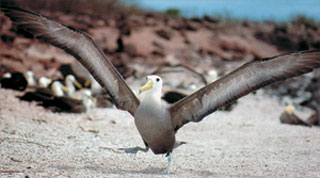 |
With regard to flight, scientists look to birds, the experts on the subject.the Exulans manufacturers examined the features of birds in order to develop their planes, although it was exceedingly difficult for them to copy the fine details in nature.2
Joachim Huyssen, designer of the Exulans plane, praises the structure of albatrosses in their ability to make controlled wing descents in restricted areas:
We observe birds, and especially in terms of their qualitative aspects of flight, we look specifically at their method of control during take off, flight and landing. One bird that is of particular interest is the albatross—it is regarded as the bird with the highest efficiency. It is a relatively heavy bird with regard to the wing size, although the wing span is quite large, but it definitely has the best lift to drag ratio in nature.3
Statements by researchers engaged on projects to imitate birds are full of amazement and praise. Yet none of this praise should actually be directed at the birds themselves, which are quite unaware of their superior properties and incomparable abilities. These creatures made no contribution to the superior characteristics they possess. We should direct our praise towards Almighty Allah, the true Lord of these superior characteristics and the most worthy of praise. However, we must also remember that only we are in need of the praise we give to our Lord. In one verse of the Qur'an, Allah reveals:
...If you were to be ungrateful, you and everyone on the Earth, Allah is Rich Beyond Need, Praiseworthy." (Surah Ibrahim, 8)
Other Differences Between Birds and Dinosaurs
The differences between dinosaurs and birds are not limited to those discussed earlier. There are many other differences such as the structures of their teeth and talons, their metabolisms, their skulls, and their eggs. Birds and reptiles possess entirely different anatomies, specially created in accord with the vertebrate's own lifestyle. If a reptile is claimed to have turned into a bird, then this must have taken place instantaneously, in a manner reminiscent of fairy-tale transformations. Stage-by-stage transformation cannot perfect a living thing, as evolutionists would have you believe. On the contrary, it will merely make the offspring less efficient. However, it is impossible to any perfect living thing to emerge in a subsequent generation by some chance re-arrangement of its genetic structure.
Alan Feduccia emphasizes that there are a great many problems with the claims that dinosaurs evolved into birds:
It's biophysically impossible to evolve flight from such large bipeds with foreshortened forelimbs and heavy, balancing tails. Exactly the wrong anatomy for flight. 96
Toe Structure
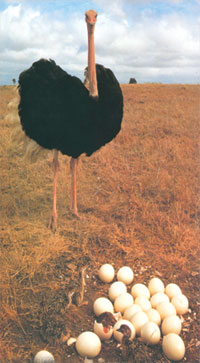 |
| Scientists who examined the development of the embryos in ostrich eggs revealed that it was impossible for bird's wings to have evolved from dinosaurs' forelimbs. |
Alan Feduccia and Dr Julie Nowicki, both from University of North Carolina, recently studied the development of ostrich eggs. Examining the forelimbs of the ostrich embryos they examined, Feduccia and his team revealed that birds and theropod dinosaurs have different toe sequences, for which reason birds' wings could not have evolved from the forefeet of dinosaurs.
Feduccia's statements and the problems this poses for evolutionists are described on the American Development of Science Society's website:
"Whatever the ancestor of birds was, it must have had five fingers, not the three-fingered hand of theropod dinosaurs," Feduccia said. "Scientists agree that dinosaurs developed 'hands' with digits one, two and three -- —Our studies of ostrich embryos, however, showed conclusively that in birds, only digits two, three and four, which correspond to the human index, middle and ring fingers, develop, and we have pictures to prove it," said Feduccia . . . This creates a new problem for those who insist that dinosaurs were ancestors of modern birds. How can a bird hand, for example, with digits two, three and four evolve from a dinosaur hand that has only digits one, two and three? That would be almost impossible." 97
Feduccia and Nowicki investigated the developmental stages of ostrich eggs and published the results of their research in the August 2002 edition of the eminent German biology journal Naturwissenschaften. Feduccia stated that their research proved that birds did not evolve from dinosaurs, summarizing their conclusions in these words:
Whatever the ancestor of birds was, it must have had five fingers, not the three-fingered hand of theropod dinosaurs. 98
As a result of their research, Alan Feduccia and A. C. Burke concluded in Science magazine that it was not possible to maintain that birds originated from dinosaurs:
It is unlikely that a shift between the typical amniote mode of development that generates digit IV through the primary axis, to a limb that develops digit III through a convergent primary axis, would maintain the pattern of cartilage condensation that is identical in avian, crocodilian, chelonian, and mamalian limbs… 99
These conclusions later appeared in the well-known journal New Scientist, under the heading "Dinosaur theory put to flight: birds may not be descended from the ancient reptiles after all":
Traditional thinking about the ancestry of birds has been challenged by biologists in the US. They say that a comparison of dinosaur claws with bird wings and feet contradicts the widespread theory that birds evolved from small, flesh-eating dinosaurs 150 million years ago.
Birds, reptiles and mammals all have four limbs, each with up to five digits...
But dinosaur fossils tell a different story. In theropods, the fourth and fifth digits are greatly diminished or have disappeared altogether. Feduccia maintains that animals which had lost these digits could not then evolve into birds that lack one and five. 100
Despite having spent years defending the idea that birds were descended from theropod dinosaurs, Peter Dodson, who works as a dinosaur paleontologist at the Veterinary School at University of Pennsylvania, expresses his opinion regarding the accuracy of the evidence to the contrary:
That has been the prevailing faith for the past twenty years. They are doing a first-class job of shaking things up and making us re-examine the evidence. 101
As you see, in order for a dinosaur to turn into a bird, every point in its body, right down to its toes, would have to change and assume a specific structure to permit the bird to fly. Any transition from a dinosaur to a flying bird is one that not even reasoning, conscious human beings can perform, let alone unconscious mechanisms such as natural selection and mutations. Even if there were no evidence to disprove evolution, the use of reason and logic alone has countless times shown the theory to be invalid. Anyone whose intellect is not shrouded with prejudice will realize that a bird's features could not have emerged of their own accord, but are the work of a Creator possessed of a superior mind and knowledge. The wisdom that brought them into being belongs to Allah, Lord of all in heaven and Earth.
Teeth
Birds have beaks rather than teeth, one of the distinguishing features between them and reptiles. However, some birds that lived in the past did have toothed beaks. This was long presented as evidence of evolution, but it was gradually realized that bird teeth have a most unique structure.
Feduccia has this to say:
Perhaps the most impressive difference between theropods and birds concerns the structure of teeth and the nature of their implantation. . . It is astounding that more attention has not been given to the dramatic differences between bird and theropod teeth, especially when one considers that the basis of mammal paleontology involves largely tooth morphology. . . . To be brief, bird teeth (as seen in Archaeopteryx, Hesperornis, Parahesperornis, Ichthyornis, Cathayornis, and all toothed Mesozoic birds) are remarkably similar and are unlike those of theropods . . . There is essentially no shared, derived relationship of any aspect of tooth morphology between birds and theropods, including tooth form, implantation, or replacement. 102
David Williamson of North Carolina at Chapell Hill makes the following statements in an article titled "Scientist says ostrich study confirms bird hands unlike those of dinosaurs" published on 14 August, 2002:
If one views a chicken skeleton and a dinosaur skeleton through binoculars, they appear similar, but close and detailed examination reveals many differences, Feduccia said. Theropod dinosaurs, for example, had curved, serrated teeth, but the earliest birds had straight, unserrated peg-like teeth. They also had a different method of tooth implantation and replacement. 103
Metabolic Differences
Another difference between reptiles and birds is their metabolisms. Reptiles possess the slowest metabolisms among quadrupeds, while birds hold the record for the fastest. To put it another way, reptiles expend the least energy, and birds the most. For example, because of its fast metabolism, a sparrow's body temperature can sometimes rise to as much as 48° C. This high temperature could only spell death for a terrestrial vertebrate, but is of vital importance to birds in increasing their production of energy, and thus strength.
Birds consume a great deal of energy in flying and for that reason, they possess the highest proportion of muscle tissue relative to their bodies. Their metabolisms have been arranged in direct proportion to the power expended by their muscles. On the other hand, reptiles are known as "cold-blooded" and cannot create their own body heat, instead warming themselves through the Sun's rays. For the most part, their body temperatures are equal to their surroundings.
Birds and mammals, of course, are warm blooded. Their bodies are able to produce heat to protect them from the cold, and also to cool them down when it is very hot. Their metabolisms are exceedingly different, and it is impossible for a reptile's cold-blooded metabolism to turn into a warm-blooded one. Some evolutionists therefore began to maintain that dinosaurs were warm-blooded. Yet there is a great deal of evidence against this thesis, which is based upon no evidence at all. 104
The fact that bird feathers are shed symmetrically on both wings cannot be explained in terms of chance
Birds molt their feathers periodically in order to maintain their flying ability. This generally takes place once a year: Since they are unable to fulfill their functions, worn or damaged flight feathers are rapidly replaced.
Molting is an exceedingly systematic process, and takes place in such a way that no area remains wholly devoid of feathers. Tail and wing feathers are shed systematically, in pairs, one from each side, preventing any loss of balance..1
1. A. Hickman, L. Roberts, A. Larson, Integrated Principles of Zoology, McGraw- Hill, New York, 2001, s. 588.
First off, there is no reason to think that dinosaurs were warm blooded, in contrast to all other reptiles. Asked whether there was any evidence in the fossil record (or anywhere else) to indicate that dinosaurs were warm blooded, Thomas E. Williamson of the New Mexico Museum of Natural History and Science replies:
As yet, there is probably no evidence that would definitively prove whether or not some dinosaurs were warm-blooded. Scientists have explored numerous lines of evidence to try to answer this question. There is a clear difference in bone structure between modern cold-blooded and warm-blooded animals. 105
Despite his evolutionist views, Peter Dodson, an eminent present-day paleontologist, has demolished the warm blooded dinosaur thesis and the idea that birds originated from dinosaurs:
...I am tepid on endothermic dinosaurs; I am skeptical about the theropod ancestry of birds. 106
There is no evidence that dinosaurs were warm blooded; on the contrary, they possess external mechanism used by cold-blooded animals to regulate their body temperatures. 107 However, due to Darwinists' dogmatic belief in evolution, they persist as if there were some evidence for their claims and continue to ignore all the evidence to the contrary.
Differences in Bodily Systems
Since birds expend a great deal of energy, they need to thoroughly digest the food they eat. Indeed, their digestive systems have a special structure that lets them use what they eat most efficiently. For example, a growing stork gains 1 kilogram (2.204 pounds) of weight with every kilos (6.613 pounds) of food. The equivalent rate in mammals eating the same foods is 1 kilo (2.204 pounds) of weight for 10 kilos (22.04 pounds).
Birds' circulatory systems have also been created in line with their high-energy requirements. The human heart beats an average of 78 times a minute, in contrast to 460 times for a sparrow, and 615 for a hummingbird. Since active flight requires a high level of energy, their blood circulation takes place much more quickly than in terrestrial animals. The oxygen needed for the high metabolic rate and energy expenditure is absorbed into the body by means of special lungs. Birds also differ significantly from reptiles in having four-chamber hearts, compared to the three chambers in reptiles'.
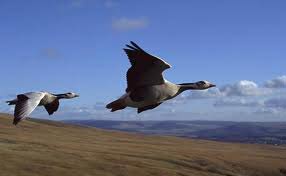 |
Thanks to Their Special Anatomy, Birds can Migrate Under Difficult Conditions
Some migratory birds fly at extraordinary heights. The bar-headed goose flies over the Himalayas at altitudes greater than 9,000 meters (29,527.56 feet)— close to where the stratosphere begins. A pair of red vultures achieved the greatest altitude ever determined—12,000 meters (39,370 feet), where oxygen levels are less than a third of those at sea level.
To be able to fly in such low oxygen levels, geese and other highflying birds need hemoglobin molecules able to carry the necessary oxygen in their blood and dense capillary vessels to transmit this oxygen to their flight muscles.
The intense cold at such heights poses another danger. Temperatures at these altitudes can fall to under –15o C. Migratory birds must spend several days flying at these freezing temperatures. But possessing the ideal structures for such conditions, they overcome the difficulties of this journey. By the mercy of our Lord, they are created with the ideal structures and systems for the conditions they must face. 1
1. John Downer, Supernature, The Unseen Powers of Animals, Sterling Publishing Co., Inc., New York, 1999, ss. 121-122.
The Differences in Skulls and Jawbones
Comparisons between the skulls of the two groups also reveal no similarity between them. As the result of an investigation carried out in 1999, Dr Andrzej Elzanowski, head of Vertebrate Zoology at the Polish Zoology Institute, concluded that "there are no similar features between the jaw and palate in theropod dinosaurs and those in birds." 108
Compared to reptiles and other four-footed creatures, most of the bones in birds' skulls and rear legs are very different. 109
On the other hand, the ophthalmic nerves in all theropods extend around the skull together with certain other nerves. In birds, however, those same nerves pass through special holes in the front of the skull. Therefore, every stage of evolutionists' search for similarities has ended in disappointment.
Furthermore, a bird's facial structure bears absolutely no resemblance to any reptile's. Fish, reptiles, amphibians and all mammals open their mouths by lowering their jawbones. Their upper jaws are immobile, since they are a fixed part of their skulls. Instead of jaws, however, birds have beaks and, in contrast to other animals, they are able to raise the upper part of their beaks as well as lowering the bottom section.
 |
| We supjected the mountains the glorify with him [Davud] in the evening and at sunrise.And also the birds flocking together, all of them turned to Him.(Surah Sad, 17-18) |
Eggs
Ignoring all the other insuperable differences, evolutionists have portrayed birds' and reptiles' eggs as evidence of a similarity between the two. Yet here, too, they present erroneous inferences based on biased interpretations. Insects, amphibians, many fish and a few mammals lay eggs in the same way. Yet the eggs of these different species are all different.
Bird eggs have a brittle shell, whereas the shell of reptile eggs is leathery. All birds lay eggs, but not all reptiles do. Some reptiles give birth to their young (lizards and rattlesnakes) like mammals. It is therefore impossible to arrive at a sound conclusion through the false inference that dinosaurs and birds lay eggs, and are therefore descended from one another.
In addition, because their backbone stretching back from their skulls consists of vertebrae, birds are called vertebrates. Counting their legs and wings, birds have four joints, for which reason they are known as four-footed (or tetrapods). After a bird's egg has been laid, the chick inside is nourished by a membrane system containing an amnion. For that reason, birds are also called amniotes (as are any other vertebrates with an amnion and corona during embryological development, such as reptiles and mammals). 110 Birds are completely different from dinosaurs in terms of these characteristics.
Equilibrium System
Like all other living things, Allah has created birds in a flawless manner, which reveals itself in every detail. Their bodies have been specially created to prevent any possible imbalance during flight. To prevent the bird from tipping over forward when flying, its skull is very light. The average weight of any bird skull represents only 1% of its body weight.
The feathers in the wing and tail regions in particular endow the bird with a most effective system of balance. The symmetry in the distribution of the feathers helps establish this equilibrium. All these characteristics enable a peregrine falcon (falcon pereginus), for example, not to overbalance when swooping down onto its prey at a speed of 300 kilometers an hour (186.411 miles per hour).
Conclusion
None of these characteristics distinguishing birds from terrestrial vertebrates can have emerged through random mutations. Even if we hypothesize that one of these features did come into being through chance mutations—which is itself impossible—that feature will offer no advantage on its own. In the absence of an air-type lung, development of the metabolism that provides the high levels of energy necessary for flight will serve no purpose. On the contrary, the creature will suffocate, being unable to obtain sufficient oxygen. In the event that an air-type lung develops first, the creature will then absorb too much oxygen and will again suffer as a result.
Another impossibility stems from skeletal structure: even if the bird is in some way in possession of an air type lung plus the appropriate metabolism—an impossibility—it will still offer no advantage. No matter how strong a creature may be, it will be unable to take off without a skeletal structure relatively lighter than any terrestrial animal's. As made clear earlier, formation of wings requires a totally different and flawless creation.
In his book Janus: A Summing Up, a criticism of the Darwinist theory of evolution, the famous author Arthur Koestler makes the following commentt:
Equally chilling is the idea that some ancestral reptiles became transformed into birds by the small, step-by-step changes caused by random mutations affecting different organs. In fact, one gets goose-pimples at the mere thought of the number of Monod's roulette wheels which must be kept spinning to produce the simultaneous transformation of scales into feathers, solid bones into hollow tubes, the outgrowth of air sacs into various parts of the body, the development of the shoulder muscles and bones to athletic proportions, and so forth. And this rewasting of bodily structure is accompanied by basic changes in the internal systems, including excretion. Birds ... instead of diluting their nitrogenous waste in water, which is a heavy ballast, they excrete it from the kidneys in a semi-solid state through the cloaca. Then there is also the little matter of the transition, by 'blind chance,' from the cold-blooded to the warm-blooded condition. There is no end to the specifications which have to be met to make our reptile airborne or to construct a camera eye out of living software. 111
All this leads us to the single conclusion that birds cannot have evolved from dinosaurs, because no mechanism could eliminate the enormous differences between the two groups. Even evolutionist scientists admit the truth of this evidence, which shows once again that the dino-bird hypothesis is simply a Darwinist myth.
The Flawless Energy Calculations in Bird Flight
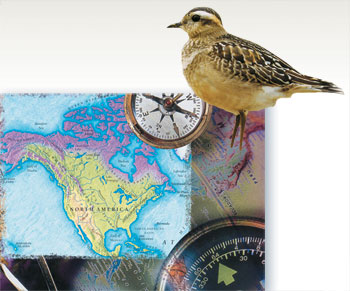 |
The way birds acquire propulsive force in flight is one of their most impressive aspects. A great many features of bird flight cannot be replicated technologically. A plane must maintain a rather high speed in order to remain in the air, but birds also make use of the air currents from their wing beats to fly more slowly. The bird wing acts like a propeller. Another function of the wing is to serve as a supporting surface. The high efficiency of this function still cannot be achieved by technological means.
One of the many problems that birds overcome during flight is energy consumption: According to the laws of physics, a specific level of energy is required for any physical, technological or biological process to take place. Migratory birds must store sufficient fat in their bodies to be able to undertake their long journeys. But since birds must also be as light as possible, they need to be free of all unnecessary weight. Thus there is an exquisite equilibrium in their fuel consumption, and in their flight speeds. If a bird flies more slowly, it will consume more energy to propel itself. If it moves too quickly, it will again expend more energy in order to overcome air resistance. Therefore, the bird can fly economically only when it attains the most appropriate speed for the least fuel consumption. Depending on the aerodynamic structure of its own body and wings, every species has its own optimal flight speed. For example, this is 45 kilometers (27.961 miles) per hour in an Aztec dove, and 41.6 km/h (25.849 mph) for a parakeet. Birds constantly maintain these optimal flight speeds to permit energy savings,1 but how they do so is still a mystery to ornithologists..1
The fuel consumption of an American golden plover (Pluvialis dominica fulva), for example, requires a very delicate calculation. Plovers migrate from Alaska to Hawaii for the winter, flying non-stop over the ocean because there are no islands en route and unlike seabirds, they cannot rest on the water. They manage their 4,000-kilometer (2,485-mile) journey in 88 hours, beating their wings continuously 250,000 times. They use up 70 grams (0.154 pound) of their 200-gram (0.440 pound) body weight as fuel.
To obtain the necessary propulsive force and heat to be able to fly, this bird consumes an estimated 0.6% of its body weight every hour. This means that after 72 hours—81% of the duration of its journey, this bird will have consumed 70 grams (0.154 of a pound) of fat as fuel, which should send it falling into the sea 800 kilometers (497.096 miles) short of its destination. Yet plovers never face such a danger, because they fly in a V-shaped formation, thus enjoying a 23% energy saving. After 88 hours, they have 6.8 grams (0.0149 of a pound) of fat left.2 However, this remaining fat is not a surplus, but is kept as a reserve in case of emergency, such as when the wind blows from the wrong direction. And so, these birds undertake an exceptionally long journey with the minimum of fuel:
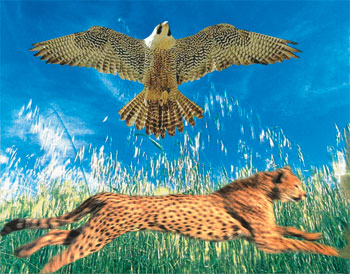 |
| Compared with running and swimming, the speed achieved during flight is very high. For example, the fastest running cheetah manages 80 kilometers/hour (49.7 miles an hour). The fastest swimming fish, the sailfish, reaches a maximum of 10 kilometers/hour (6.2 miles an hour), while a hawk can attain up to 300 kilometers/hour (186.4 miles an hour) as it dives with its wings folded. (1) Moreover, in comparison with the distance traveled, the energy expended is far less than that in swimming or running. A cheetah, for instance, reaches its top speed in 3 seconds, but must expend a high level of energy to overcome inertia. Its internal body temperature reaches 40°C during this process. In terms of energy expended over distance traveled, therefore, birds have been created with an incomparably more efficient structure. |
| 1. John Downer, Supernature, The Unseen Powers of Animals, Sterling Publishing Co., Inc., New York, 1999, ss. 114-117. |
Professor Werner Gitt, director of the German Federal Physics and Technology Institute, expresses his admiration for this economical energy consumption :
The extremely low specific rate of fuel consumption, p=0.6% of its weight per hour, is all the more amazing when we compare it that of manmade aircraft which is many orders of magnitude greater (for a helicopter p=4 to 5%; and p= 12% for a jet plane). 3
Experts must make complex calculations to obtain these figures, but a bird cannot make such flawless calculations on its own behalf. Another factor here is that every incomplete flight will end in the plover's drowning. There can be no question of this ideal fuel consumption being learned by trial and error, nor of one bird's' experiences being handed on to later generations. Therefore, in order to carry out this potentially lethal journey, the plover must be able to make the entire flight from the moment it has learned to fly. It is of course impossible for a bird to know:
◉ Its destination and the shortest route to it,
◉ How far away that destination is,
◉ The speed at which it must fly,
◉ How much energy it must expend to fly that distance,
◉ How much fat it will have to store to accomplish it,
◉ That it needs to fly in a V formation with others to reduce the energy it consumes,
◉ That it must set aside a reserve of fat in case of adverse weather conditions.
No chance or unconscious mechanism can determine a bird's ideal flight formation or speed, nor how much stored energy it will need. That these creatures, lacking the ability to take decisions and judgment, fly with such a rational plan and calculated techniques can be explained by their possessing the ideally appropriate bodily structures: These birds behave according to the inspiration given them from the moment of their creation. They live out their lives through the commands and supervision of our Lord, the Creator of all things.
The Fossil Record Refutes Evolution
Looking at the realm of fossils in particular, we encounter concrete evidence that evolution never took place. All living things appear suddenly in the fossil record, complete with all their unique physical structures, with no transitional ancestors at all... (For details, see Harun Yahya's The Evolution Deceit fromTa-Ha Publishers Ltd. 1999; and Darwinism Refuted, from Goodword Books, New Delhi, 2002.) Since their fossils have been very well preserved, birds offer particularly rich evidence refuting the claims of evolution.
 |
| (1,2,3,4) The imaginary intermediate forms which evolutionists claim should exist |
Despite the wide-ranging scientific research of the last 160 years, no evidence to support Darwin's so-called theory of evolution has ever emerged. Indeed, many scientists—from Darwin down to the present—admit that had such a process actually taken place, there should be a great deal of evidence, but that none has ever come to light.
The molecular biologist Michael Denton has this to say:
If evolution had really taken place in the past, there ought to be multitudes of transitional forms preserved in the rocks. Instead, evolutionists have been able to cite only of handful of candidates out of the billions of known fossils. These are mainly the lung fishes, the mammal like reptiles, the archaeopteryx, the horses and—more recently—the so-called walking whales. When these are examined more closely, however, they don't fill the bill at all. Either they are out of place in geologic time or they are separate kinds in their own right or both. 1
According to the theory of evolution, millions of half-reptile, half-bird creatures should have existed. The differences between these two living groups and also among millions of others should have been bridged in stages by transitional species. Therefore, had any evolutionary process taken place, then at least some of these intermediate forms should have been fossilized and survived to the present. They should be far more numerous than those species alive today.
Yet despite all the intense efforts over the last century or so to find an intermediate form, not one of the desired fossils has been found. Some evolutionists make striking confessions on this subject. This is how Charles Darwin himself, who put forward the theory, described his despair on the subject of intermediate forms in his book, The Origin of Species:
Firstly, why, if species have descendent from other species by insensibly fine gradations, do we not everywhere see innumerable transitional forms? Why is not all nature in confusion instead of the species being, as we see them, well defined? 2
After Darwin, the intensive efforts to find intermediate forms all ended in disappointment. Though an evolutionist, the well-known paleontologist Derek W. Ager, admits that the fossil records is against evolution: "The point emerges that if we examine the fossil record in detail, we find–over and over again—not gradual evolution, but the sudden explosion of one group at the expense of another." 3
Another paleontologist, Mark Czarnecki, admits that the fossil record is of such a kind as to support creation, not evolution:
...major problem in proving the theory (evolution theory) has been the fossil record. . . This record has never revealed traces of Darwin's hypothetical intermediate variants—instead, species appear and disappear abruptly, and this anomaly has fueled the creationist argument that each species was created by Allah. 4
Dino-Birds are Products of Fantasy | |
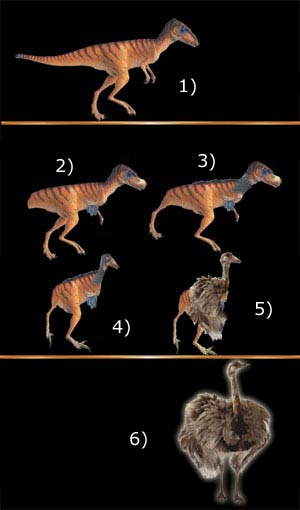 | (1) A flawless, fossilized living thing
To prove that birds evolved from dinosaurs, evolutionists should have discovered intermediate forms of the kind shown here. Yet although many fossils belonging to either dinosaurs or birds have been found in the fossil record, there is no trace of these imaginary dino-birds. Nowhere in the Earth's strata are there any extinct species with odd-looking half-reptilian, half-avian features—of which, evolutionists claim, there should be a great many. All the remains in the fossil record are flawless and complete. None are intermediate forms of the kind shown here. This is important evidence that evolution never |
Also, most of the fossils proposed by evolutionists as evidence for evolution were later found to be either forgeries, or else were misinterpreted using biased or unscientific methods. (You shall see such distortions in the next chapter.) Today, evolutionists cannot point to a single fossil as evidence. Indeed, Mark Ridley, an University of Oxford zoologist and well-known evolutionist, admits:
In any case, no real evolutionist, whether gradualist or punctuationist, uses the fossil record as evidence in favour of the theory of evolution as opposed to special creation.5
Footnotes 10
1. Michael Denton, Evolution: A Theory in Crisis, Burnett Books, London, 1985, s. 368. 
2. Charles Darwin, Türlerin Kökeni, s. 18.
3. Derek A. Ager, "The Nature of the Fossil Record", Proceedings of the British Geological Association, vol. 87, 1976, s. 133. 
4. Mark Czarnecki, "The Revival of the Creationist Crusade", MacLean's, 19 Ocak 1981, s. 56. 
5. "Who Doubts Evolution?", New Scientist, vol. 90, 25 Haziran 1981, s. 831. 
Footnotes
34. A. Koestler, The Ghost in the Machine, London, 1989, p. 127; [Conrad H.Waddington, The Listener", London,November, 13, 1952. 
35. S. L. Olson, Open Letter to: Dr. Peter Raven, Secretary, Committee for Research and Exploration, National Geographic Society,November 1, 1999 (Emphasis added). 
36. Discovery Channel, "The Ultimate Guide", April 21, 2003. 
37. Ann Gibbons, "New Feathered Fossil Brings Dinosaurs and Birds Closer," Science, Vol. 274, 1996, pp. 720-721 
38. Jonathan Sarfati, Refuting Evolution: A Response to the National Academy of Sciences, "Teaching About Evolution and the Nature of Science, "Master Books, ABD, 1999, p. 63. 
39. Gordon Rattray Taylor, The Great Evolution Mystery, London: Abacus, 1983, pp. 70-71. 
40. Henry Gee, In Search of Deep Time: Beyond the Fossil Record to a New History of Life, Comstock Publishing Assoc., USA, 1999, p. 172. 
41. Duane T. Gish, Dinosaurs by Design, Master Books, 1996, pp. 65-66. 
42. A. C. Burke, A. Feduccia, "Developmental Patterns and the Identification of Homologies in the Avian Hand," Science, Vol. 278, no. 5338, October, 24 1997, pp. 666-668. 
43. The Cincinnati Enquirer, October 25, 1997 (Emphasis added). 
44. Pat Shipman, "Birds Do It... Did Dinosaurs?", New Scientist, February 1, 1997, p. 28 (Emphasis added). 
46. Henry Gee, In Search of Deep Time: Beyond the Fossil Record to a New History of Life, p. 172. 
47. http://www.birdsnways.com/wisdom/ ww43eiv.htm 
48. http://www.wbu.com/edu/migr.htm 
49. Michael Denton, A Theory in Crisis, Adler & Adler, 1986, pp. 210-211. 
50. Ibid., pp. 211-212 (Emphasis added). 
51. Michael J. Denton, "An Interview with Michael Denton," Access Research Network, Origins Research, Vol. 15, No. 2, July 20, 1995; http://www.arn.org/docs/orpages/or152/ dent.htm (Emphasis added). 
52. J. A. Ruben, T. D. Jones, N. R. Geist, W. J Hillenius, "Lung Structure And Ventilation in Theropod Dinosaurs and Early Birds," Science, Vol.: 278, No. 5341, November 14, 1997, p. 1267. 
53. Michael J. Denton, Nature's Destiny, New York: The Free Press, , 1998, p. 361. 
55. J. A. Ruben, T.D. Jones, N.R. Geist, W.J Hillenius, "Lung Structure And Ventilation in Theropod Dinosaurs and Early Birds," Science, Vol.: 278, No. 5341, November 14, 1997, pp. 1267-1270. 
56. Jonathan Sarfati, Refuting Evolution: A Response to the National Academy of Sciences, Teaching About Evolution and the Nature of Science, Master Books, USA, 1999, p. 64; Richard Dawkins, Climbing Mount Improbable, Penguin Books, , 1996, p. 113. 
57.A. H. Brush, "On the Origin of Feathers," Journal of Evolutionary Biology, Vol: 9, 1996, p. 132. 
58. Alan Feduccia, The Origin and Evolution of Birds, New Haven: Yale University Press, 1996, p. 130. 
59. Ernst Mayr, Systematics and The Origin Of Species, New York: Dove Press, , 1964, p. 296. 
60. A. C. Lucas, P. R. Slettenhein, Avian Anatomy: Integument, GPO, Washington, D.C., 1972. 
61. A. H. Brush, "On the origin of feathers," Journal of Evolutionary Biology, pp. 131-142. 
62. "Bird Evolution Flies out the Window: An anatomist talks about Archæopteryx:" David Menton with Carl Wieland, Creation Ex Nihilo, Vol. 16, No. 4, July-August 1994, pp. 16-19. 
63. Xing Xu, Zhi-Lu Tang, Xiao-Lin Wang, "A therizinosauroid dinosaur with integumentary structures from China," Nature, Vol. 399, 1999, pp. 350-354 (Emphasis added). 
64. W. E. Swinton, "The Origin of Birds," Biology and Comparative Physiology of Birds, Ed. A. J. Marshall, New York: Academic Press, , 1960.(Emphasis added). 
65. W. J. Bock, "Explanatory History of the Origin of Feathers," American Zoology, Vol. 40, Sep. 2000, p. 480. 
66. Barbara J. Stahl, Vertebrate History: Problems in Evolution, New York: Dover Publications, , 1985, pp. 349-350 (Emphasis added). 
68. Larry Martin, S. A. Czerkas, "The Fossil Record of Feather Evolution in the Mesozoic," American Zoologist, Vol. 40, Sep.2000, p. 687. 
69. "Bird Evolution Flies out the Window", Carl Wieland, Creation Ex Nihilo, Vol. 16, Issue: 4, July-August 1994, pp. 16-19. 
70. K. Parkes, "Speculations on the Origin of Feathers," Living Bird, Vol. 5, 1966, p. 77. 
71. W. P. Pycraft, "Animal Life: an Evolutionary Natural History," A History of Birds, Vol .2, Methuen, London, p. 39. 
72. Larry Martin, S. A. Czerkas, ""The Fossil Record of Feather Evolution in the Mesozoic," American Zoologist, p. 687. 
73. Richard O. Prum, Alan H. Brush, "Which Came First the Feather or the Bird?", Scientific American, March 2003, pp. 84-93 (Emphasis added). 
74. K. Parkes, "Speculations on the Origin of Feathers," Living Bird, p. 77. 
75. W. P. Pycraft, "Animal Life: an Evolutionary Natural History," A History of Birds, Vol. 2, Methuen, London, p. 39. 
76. Alan Feduccia, "On Why Dinosaurs Lacked Feathers," The Beginning of Birds, Eichstatt, West Germany, Jura Museum, 1985, p. 76 (Emphasis added). 
77. Ann Gibbons, "Plucking the Feathered Dinosaur,: Science, Vol. 278, Issue. 5341, 14 November 1997, pp. 1229-1230. 
79. Alan Feduccia, The Origin and Evolution of Birds, Yale University Press, 1999, p. 130. 
81. A. H. Brush, "On the Origin of Feathers," Journal of Evolutionary Biology, Vol. 9, 1996, p. 132 
82. Richard O. Prum, "Development and Evolutionary Origin of Feathers," Journal of. Experimental Zoology, Vol. 285, p. 292. 
83. David Menton, "Bird evolution flies out the window," Creation, pp. 16-19. 
84. Ann Gibbons, "New Feathered Fossil Brings Dinosaurs and Birds Closer," Science, Vol .274, 1 November 1996. 
85. Douglas Palmer, "Learning to Fly," New Scientist, Vol. 153, 1 March 1997, p. 44 (Emphasis added). 
86. Alan Feduccia, The Origin and Evolution of Birds, New Haven: Yale University Press, , 1996, p. 130. 
87. Richard Dawkins, River Out of Eden, New York: Basic Books, 1995, p. 83 (Emphasis added). 
88. Daniel C. Dennett, Darwin's Dangerous Idea, New York: Simon & Schuster, , 1996, pp. 59-60 (Emphasis added). 
90. Engin Korur, "Gözlerin ve Kanatların Sırrı [The Secret of Eyes and Wings]," Bilim ve Teknik, No. 203, October 1984, p. 25. 
91. S. J. Gould, The Panda's Thumb, W. W. Norton & Company (August 1992), p.189 (Emphasis added). 
92. 91. Richard Milton, Son Tartışmalar Işığında Darwinizm'in Mitleri, (Shattering the Myths of Darwinism) Gelenek Publishing House, September 2003, translated by: İbrahim Kapaklıkaya, p. 202. 
93. Colin J. Pennycuick, Bird Flight Performance, Oxford University Press, 1989. 
94. "Flying High, An interview with Dr. Andy McIntosh;" http://www.answersingenesis.org /creation/v20/i2/flying_high.asp 
95. "New Study Suggests Missing Link That Explains How Dinosaurs Learned To Fly," 17 January 2003;http://www.sciencedaily.com/releases/2003/01/030117081305.htm 
96. "Kusursuz Uçuş Makineleri," [Flawless Flying Machines] Blim ve Teknik, No. 136, March 1979, p. 21. 
97. Jonathan Sarfati, Refuting Evolution: A Response to the National Academy of Sciences, Teaching About Evolution and the Nature of Science, Master Books, USA, 1999, p. 61. 
98. David Williamson, ""Scientist Says Ostrich Study Confirms Bird 'Hands'' Unlike Those Of Dinosaurs," EurekAlert, 14 August 2002; http://www.eurekalert.org/pub_releases/2002-08/uonc-sso081402.ph (Emphasis added). 
100. A. C. Burke, A. Feduccia, "Developmental Patterns and the Identification of Homologies in the Avian Hand," Science, Vol. 278, Issue. 5338, 24 October 1997, pp. 666-668. 
101. Jonathan Knight, "Dinosaur theory put to flight: Birds may not be descended from the ancient reptiles after all," New Scientist, 1 November 1997. 
103. Alan Feduccia, "Birds are Dinosaurs: Simple Answer to a Complex Problem," The Auk, Vol. 119, Issue. 4, October 2002, pp. 1187-1201(Emphasis added). 
104. David Williamson, "Scientist says ostrich study confirms bird hands unlike those of dinosaurs," Eurek Alert, 14 August 2002; http://www.eurekalert.org/pub_releases/ 2002-08/uonc-sso081402.php 
105. V. Morell, "A Cold, Hard Look at Dinosaurs," Discover, Vol. 17, Issue. 12, 1996, pp. 98-108. 
106. http://www.sciam.com/askexpert_question.cfm?articleID=00084771-7316-1C72-9EB7809EC588F2D7&sc=I100322 (Emphasis added). 
107. P. Dodson, "Mesozoic Feathers and Fluff," American Paleontologist, Vol. 9, Issue. 1, 2001, p. 7 (Emphasis added). 
108. http://www.sciam.com/askexpert_question.cfm?articleID=00084771-7316-1C72-9EB7809EC588F2D7&sc=I100322 
109. A. Elzanowski, "A comparison of the jaw skeleton in theropods and birds, with a description of the palate in the Oviraptoridae," Smithsonian Contributions to Paleobiology, Vol. 89, 1999, pp. 311-323. 
110. Henry Gee, In Search of Deep Time: Beyond the Fossil Record to a New History of Life, Comstock Publishing Assoc., 1999, P. 172. 
- Foreword
- Introduction
- Evolutionist Scenarios and Dilemmas Regarding the Origin of Flight
- Important Structural Differences Between Dinosaurs and Birds
- Archaeopteryx is an Extinct Species of Bird, Not an Intermediate Form
- The False Fossil Archaeoraptor: An Example of Evolutionist Fanaticism
- Imaginary Dinosaur-Bird Links
- Pterosaurs - A Dilemma for the Theory of Evolution
- The Origin of Flight in Insects
- Conclusion
